Brand Management Report: Strategies, Portfolio, and Equity
VerifiedAdded on 2020/07/22
|19
|5075
|120
Report
AI Summary
This report delves into the critical aspects of brand management, emphasizing its importance as a marketing tool for businesses. It examines key components of successful brand strategies, including building and managing brand equity, with a focus on customer-based brand equity (CBBE) models, brand reinforcement, and brand revitalization. The report further explores different strategies for portfolio management, brand hierarchies, and brand equity management, analyzing the hybrid architectural models employed by companies like Amazon and Ebay. It also discusses the collaborative management of brands at both domestic and global levels, and the various techniques used for measuring and managing brand value. The report concludes with a comprehensive overview of how these elements contribute to effective brand management in the modern business landscape, highlighting the significance of adapting to market changes and maintaining a strong brand image.
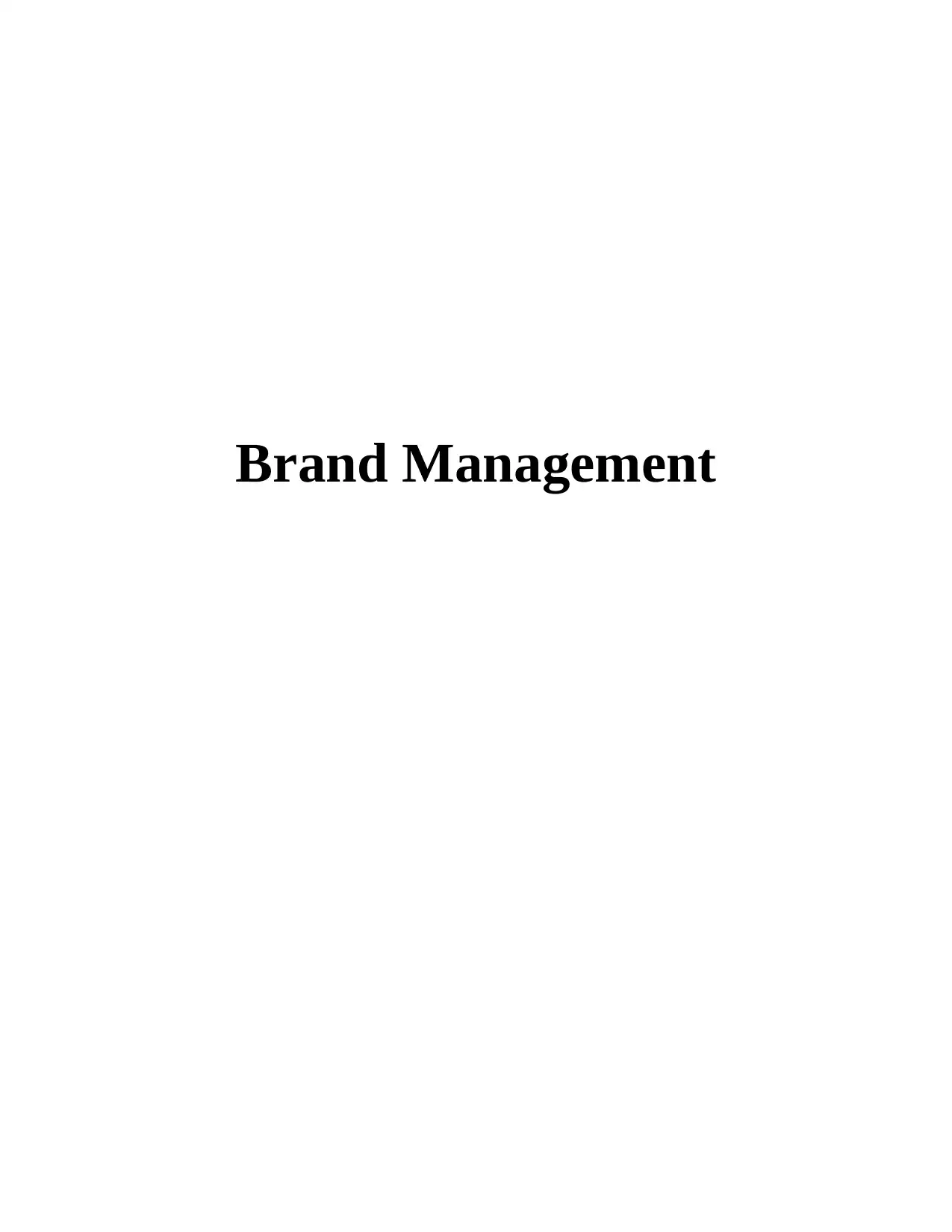
Brand Management
Secure Best Marks with AI Grader
Need help grading? Try our AI Grader for instant feedback on your assignments.
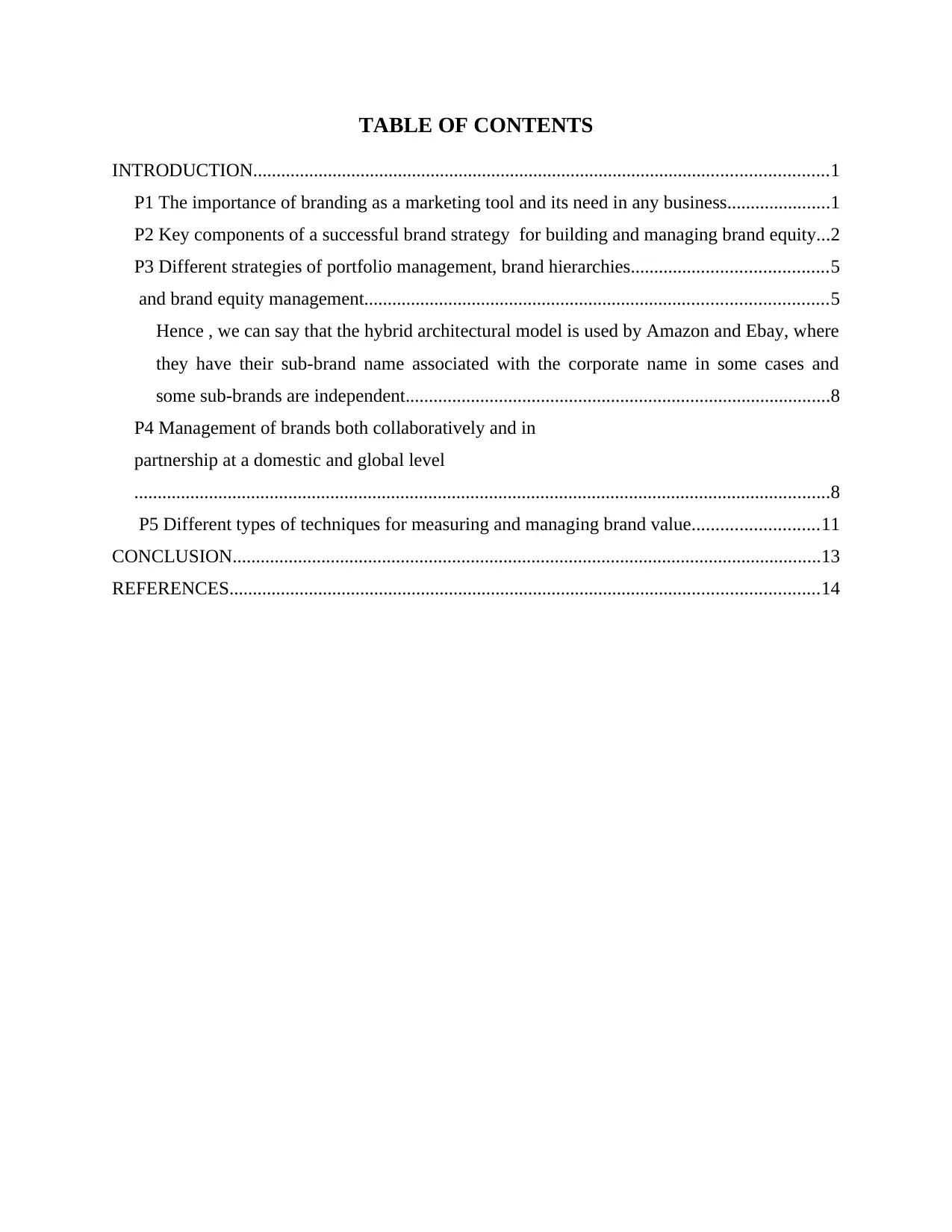
TABLE OF CONTENTS
INTRODUCTION...........................................................................................................................1
P1 The importance of branding as a marketing tool and its need in any business......................1
P2 Key components of a successful brand strategy for building and managing brand equity...2
P3 Different strategies of portfolio management, brand hierarchies..........................................5
and brand equity management...................................................................................................5
Hence , we can say that the hybrid architectural model is used by Amazon and Ebay, where
they have their sub-brand name associated with the corporate name in some cases and
some sub-brands are independent...........................................................................................8
P4 Management of brands both collaboratively and in
partnership at a domestic and global level
.....................................................................................................................................................8
P5 Different types of techniques for measuring and managing brand value...........................11
CONCLUSION..............................................................................................................................13
REFERENCES..............................................................................................................................14
INTRODUCTION...........................................................................................................................1
P1 The importance of branding as a marketing tool and its need in any business......................1
P2 Key components of a successful brand strategy for building and managing brand equity...2
P3 Different strategies of portfolio management, brand hierarchies..........................................5
and brand equity management...................................................................................................5
Hence , we can say that the hybrid architectural model is used by Amazon and Ebay, where
they have their sub-brand name associated with the corporate name in some cases and
some sub-brands are independent...........................................................................................8
P4 Management of brands both collaboratively and in
partnership at a domestic and global level
.....................................................................................................................................................8
P5 Different types of techniques for measuring and managing brand value...........................11
CONCLUSION..............................................................................................................................13
REFERENCES..............................................................................................................................14
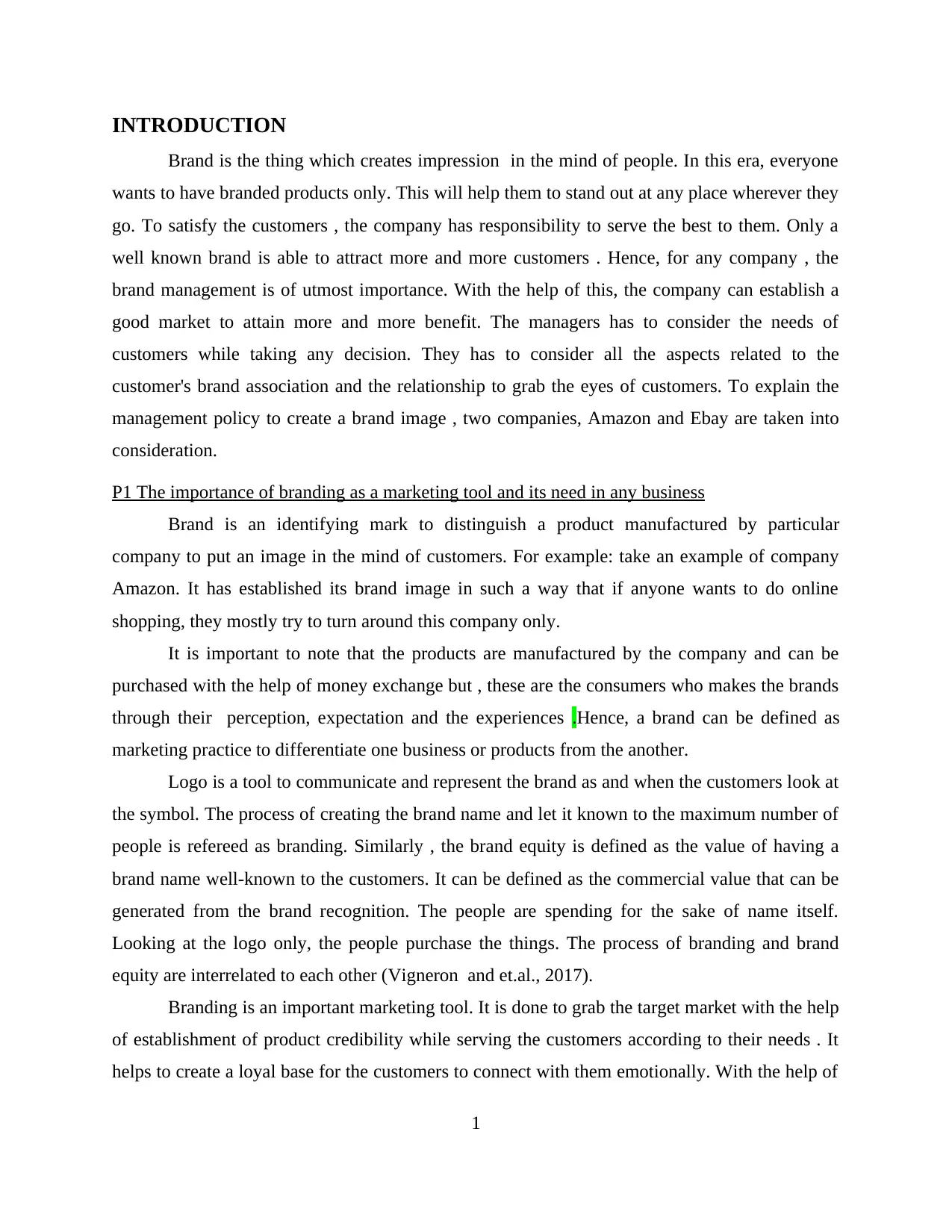
INTRODUCTION
Brand is the thing which creates impression in the mind of people. In this era, everyone
wants to have branded products only. This will help them to stand out at any place wherever they
go. To satisfy the customers , the company has responsibility to serve the best to them. Only a
well known brand is able to attract more and more customers . Hence, for any company , the
brand management is of utmost importance. With the help of this, the company can establish a
good market to attain more and more benefit. The managers has to consider the needs of
customers while taking any decision. They has to consider all the aspects related to the
customer's brand association and the relationship to grab the eyes of customers. To explain the
management policy to create a brand image , two companies, Amazon and Ebay are taken into
consideration.
P1 The importance of branding as a marketing tool and its need in any business
Brand is an identifying mark to distinguish a product manufactured by particular
company to put an image in the mind of customers. For example: take an example of company
Amazon. It has established its brand image in such a way that if anyone wants to do online
shopping, they mostly try to turn around this company only.
It is important to note that the products are manufactured by the company and can be
purchased with the help of money exchange but , these are the consumers who makes the brands
through their perception, expectation and the experiences .Hence, a brand can be defined as
marketing practice to differentiate one business or products from the another.
Logo is a tool to communicate and represent the brand as and when the customers look at
the symbol. The process of creating the brand name and let it known to the maximum number of
people is refereed as branding. Similarly , the brand equity is defined as the value of having a
brand name well-known to the customers. It can be defined as the commercial value that can be
generated from the brand recognition. The people are spending for the sake of name itself.
Looking at the logo only, the people purchase the things. The process of branding and brand
equity are interrelated to each other (Vigneron and et.al., 2017).
Branding is an important marketing tool. It is done to grab the target market with the help
of establishment of product credibility while serving the customers according to their needs . It
helps to create a loyal base for the customers to connect with them emotionally. With the help of
1
Brand is the thing which creates impression in the mind of people. In this era, everyone
wants to have branded products only. This will help them to stand out at any place wherever they
go. To satisfy the customers , the company has responsibility to serve the best to them. Only a
well known brand is able to attract more and more customers . Hence, for any company , the
brand management is of utmost importance. With the help of this, the company can establish a
good market to attain more and more benefit. The managers has to consider the needs of
customers while taking any decision. They has to consider all the aspects related to the
customer's brand association and the relationship to grab the eyes of customers. To explain the
management policy to create a brand image , two companies, Amazon and Ebay are taken into
consideration.
P1 The importance of branding as a marketing tool and its need in any business
Brand is an identifying mark to distinguish a product manufactured by particular
company to put an image in the mind of customers. For example: take an example of company
Amazon. It has established its brand image in such a way that if anyone wants to do online
shopping, they mostly try to turn around this company only.
It is important to note that the products are manufactured by the company and can be
purchased with the help of money exchange but , these are the consumers who makes the brands
through their perception, expectation and the experiences .Hence, a brand can be defined as
marketing practice to differentiate one business or products from the another.
Logo is a tool to communicate and represent the brand as and when the customers look at
the symbol. The process of creating the brand name and let it known to the maximum number of
people is refereed as branding. Similarly , the brand equity is defined as the value of having a
brand name well-known to the customers. It can be defined as the commercial value that can be
generated from the brand recognition. The people are spending for the sake of name itself.
Looking at the logo only, the people purchase the things. The process of branding and brand
equity are interrelated to each other (Vigneron and et.al., 2017).
Branding is an important marketing tool. It is done to grab the target market with the help
of establishment of product credibility while serving the customers according to their needs . It
helps to create a loyal base for the customers to connect with them emotionally. With the help of
1
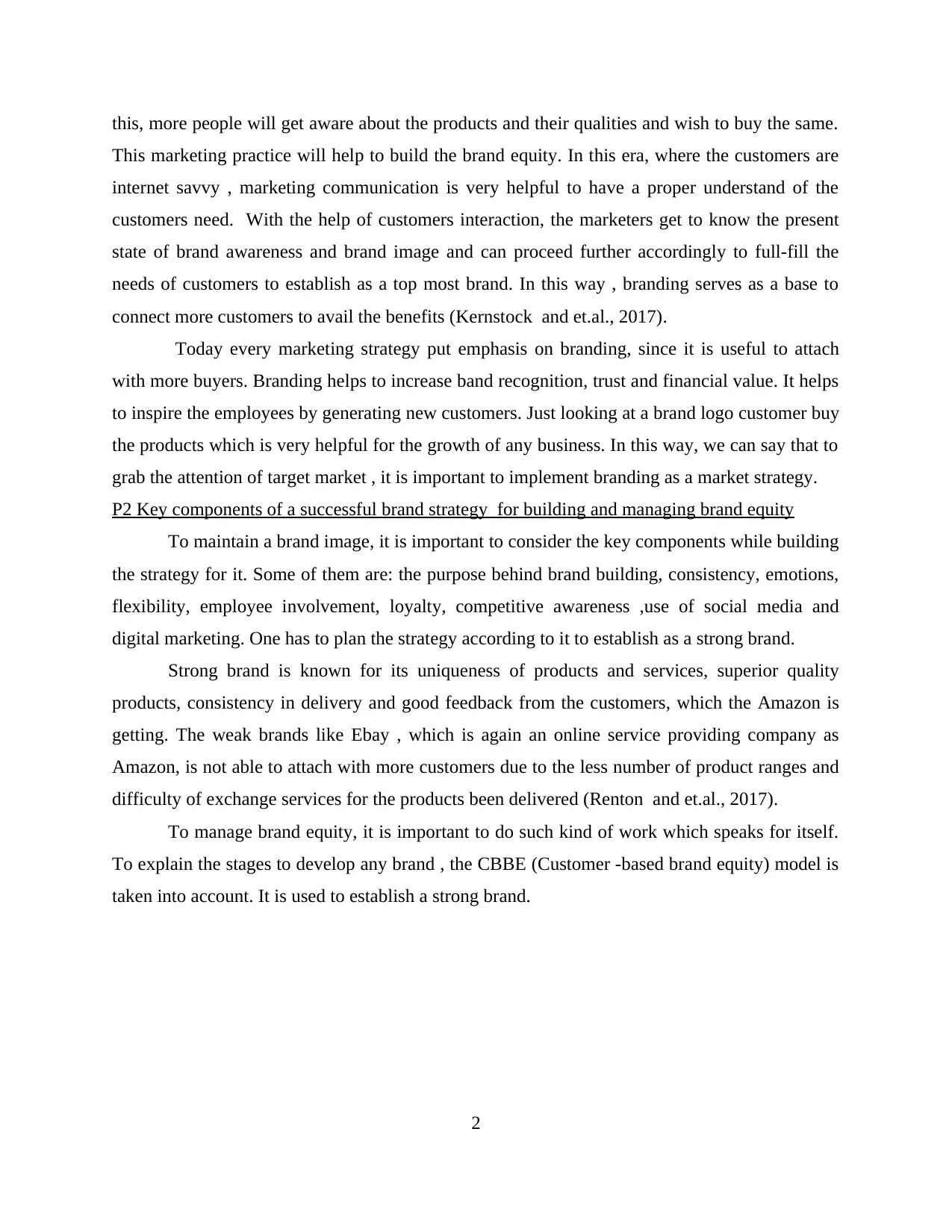
this, more people will get aware about the products and their qualities and wish to buy the same.
This marketing practice will help to build the brand equity. In this era, where the customers are
internet savvy , marketing communication is very helpful to have a proper understand of the
customers need. With the help of customers interaction, the marketers get to know the present
state of brand awareness and brand image and can proceed further accordingly to full-fill the
needs of customers to establish as a top most brand. In this way , branding serves as a base to
connect more customers to avail the benefits (Kernstock and et.al., 2017).
Today every marketing strategy put emphasis on branding, since it is useful to attach
with more buyers. Branding helps to increase band recognition, trust and financial value. It helps
to inspire the employees by generating new customers. Just looking at a brand logo customer buy
the products which is very helpful for the growth of any business. In this way, we can say that to
grab the attention of target market , it is important to implement branding as a market strategy.
P2 Key components of a successful brand strategy for building and managing brand equity
To maintain a brand image, it is important to consider the key components while building
the strategy for it. Some of them are: the purpose behind brand building, consistency, emotions,
flexibility, employee involvement, loyalty, competitive awareness ,use of social media and
digital marketing. One has to plan the strategy according to it to establish as a strong brand.
Strong brand is known for its uniqueness of products and services, superior quality
products, consistency in delivery and good feedback from the customers, which the Amazon is
getting. The weak brands like Ebay , which is again an online service providing company as
Amazon, is not able to attach with more customers due to the less number of product ranges and
difficulty of exchange services for the products been delivered (Renton and et.al., 2017).
To manage brand equity, it is important to do such kind of work which speaks for itself.
To explain the stages to develop any brand , the CBBE (Customer -based brand equity) model is
taken into account. It is used to establish a strong brand.
2
This marketing practice will help to build the brand equity. In this era, where the customers are
internet savvy , marketing communication is very helpful to have a proper understand of the
customers need. With the help of customers interaction, the marketers get to know the present
state of brand awareness and brand image and can proceed further accordingly to full-fill the
needs of customers to establish as a top most brand. In this way , branding serves as a base to
connect more customers to avail the benefits (Kernstock and et.al., 2017).
Today every marketing strategy put emphasis on branding, since it is useful to attach
with more buyers. Branding helps to increase band recognition, trust and financial value. It helps
to inspire the employees by generating new customers. Just looking at a brand logo customer buy
the products which is very helpful for the growth of any business. In this way, we can say that to
grab the attention of target market , it is important to implement branding as a market strategy.
P2 Key components of a successful brand strategy for building and managing brand equity
To maintain a brand image, it is important to consider the key components while building
the strategy for it. Some of them are: the purpose behind brand building, consistency, emotions,
flexibility, employee involvement, loyalty, competitive awareness ,use of social media and
digital marketing. One has to plan the strategy according to it to establish as a strong brand.
Strong brand is known for its uniqueness of products and services, superior quality
products, consistency in delivery and good feedback from the customers, which the Amazon is
getting. The weak brands like Ebay , which is again an online service providing company as
Amazon, is not able to attach with more customers due to the less number of product ranges and
difficulty of exchange services for the products been delivered (Renton and et.al., 2017).
To manage brand equity, it is important to do such kind of work which speaks for itself.
To explain the stages to develop any brand , the CBBE (Customer -based brand equity) model is
taken into account. It is used to establish a strong brand.
2
Secure Best Marks with AI Grader
Need help grading? Try our AI Grader for instant feedback on your assignments.
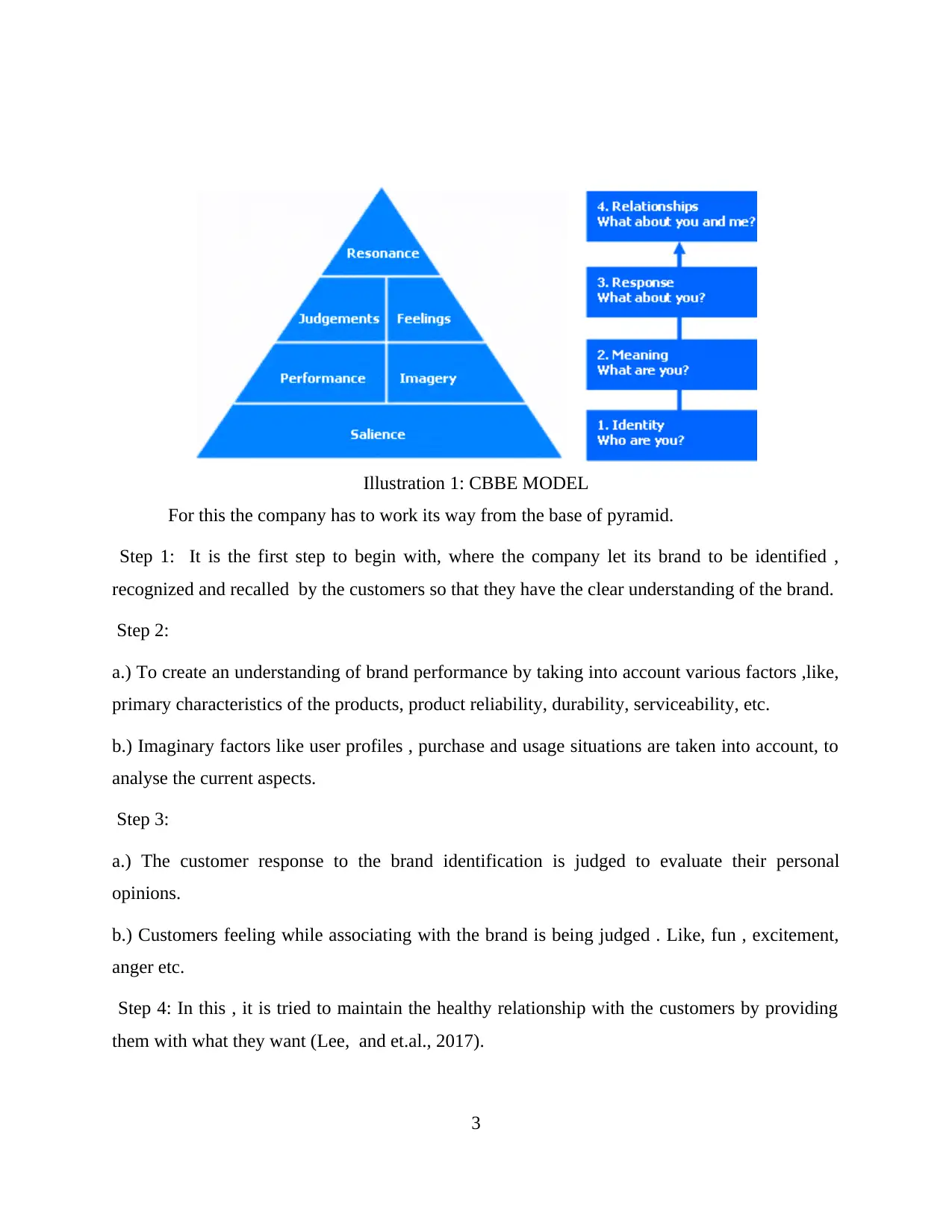
For this the company has to work its way from the base of pyramid.
Step 1: It is the first step to begin with, where the company let its brand to be identified ,
recognized and recalled by the customers so that they have the clear understanding of the brand.
Step 2:
a.) To create an understanding of brand performance by taking into account various factors ,like,
primary characteristics of the products, product reliability, durability, serviceability, etc.
b.) Imaginary factors like user profiles , purchase and usage situations are taken into account, to
analyse the current aspects.
Step 3:
a.) The customer response to the brand identification is judged to evaluate their personal
opinions.
b.) Customers feeling while associating with the brand is being judged . Like, fun , excitement,
anger etc.
Step 4: In this , it is tried to maintain the healthy relationship with the customers by providing
them with what they want (Lee, and et.al., 2017).
3
Illustration 1: CBBE MODEL
Step 1: It is the first step to begin with, where the company let its brand to be identified ,
recognized and recalled by the customers so that they have the clear understanding of the brand.
Step 2:
a.) To create an understanding of brand performance by taking into account various factors ,like,
primary characteristics of the products, product reliability, durability, serviceability, etc.
b.) Imaginary factors like user profiles , purchase and usage situations are taken into account, to
analyse the current aspects.
Step 3:
a.) The customer response to the brand identification is judged to evaluate their personal
opinions.
b.) Customers feeling while associating with the brand is being judged . Like, fun , excitement,
anger etc.
Step 4: In this , it is tried to maintain the healthy relationship with the customers by providing
them with what they want (Lee, and et.al., 2017).
3
Illustration 1: CBBE MODEL
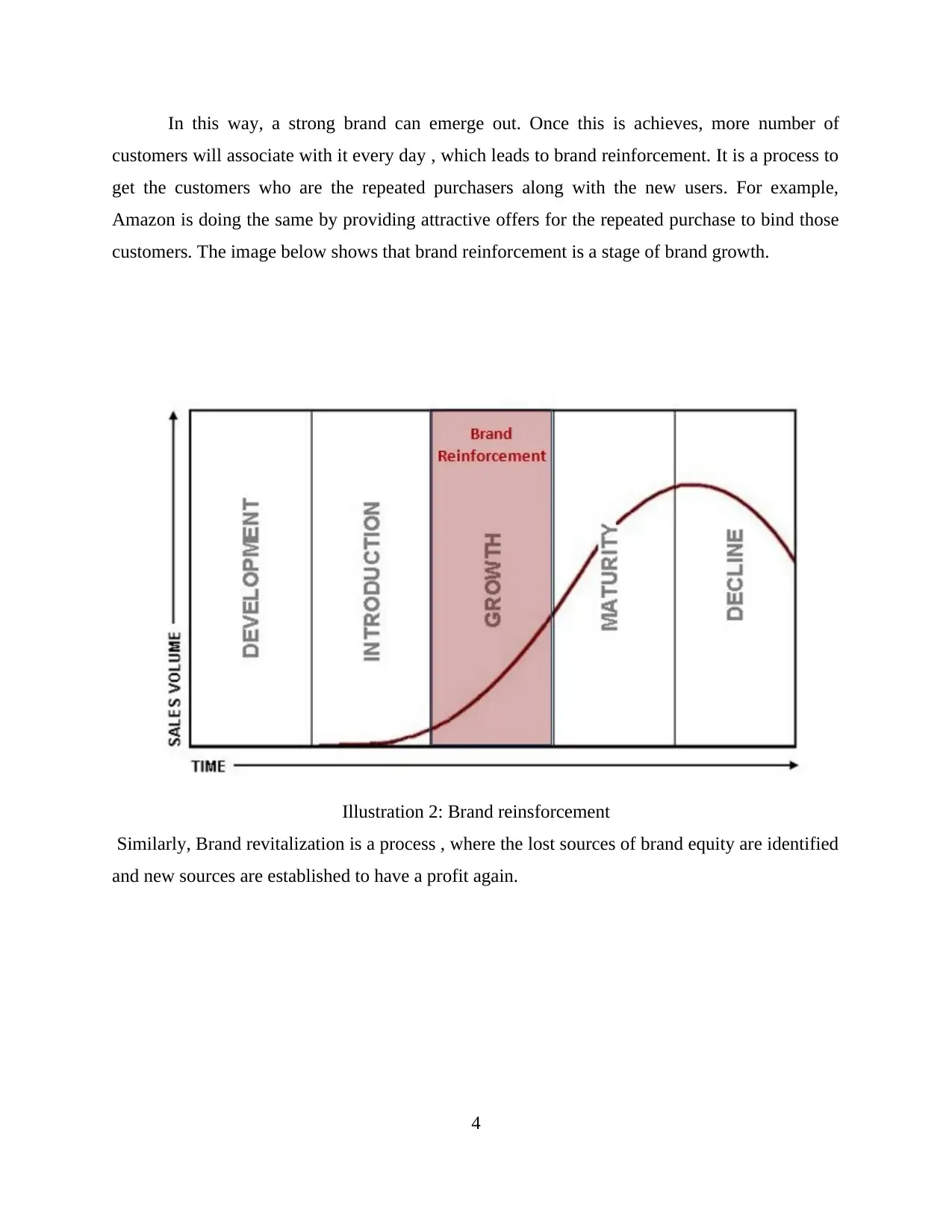
In this way, a strong brand can emerge out. Once this is achieves, more number of
customers will associate with it every day , which leads to brand reinforcement. It is a process to
get the customers who are the repeated purchasers along with the new users. For example,
Amazon is doing the same by providing attractive offers for the repeated purchase to bind those
customers. The image below shows that brand reinforcement is a stage of brand growth.
Similarly, Brand revitalization is a process , where the lost sources of brand equity are identified
and new sources are established to have a profit again.
4
Illustration 2: Brand reinsforcement
customers will associate with it every day , which leads to brand reinforcement. It is a process to
get the customers who are the repeated purchasers along with the new users. For example,
Amazon is doing the same by providing attractive offers for the repeated purchase to bind those
customers. The image below shows that brand reinforcement is a stage of brand growth.
Similarly, Brand revitalization is a process , where the lost sources of brand equity are identified
and new sources are established to have a profit again.
4
Illustration 2: Brand reinsforcement
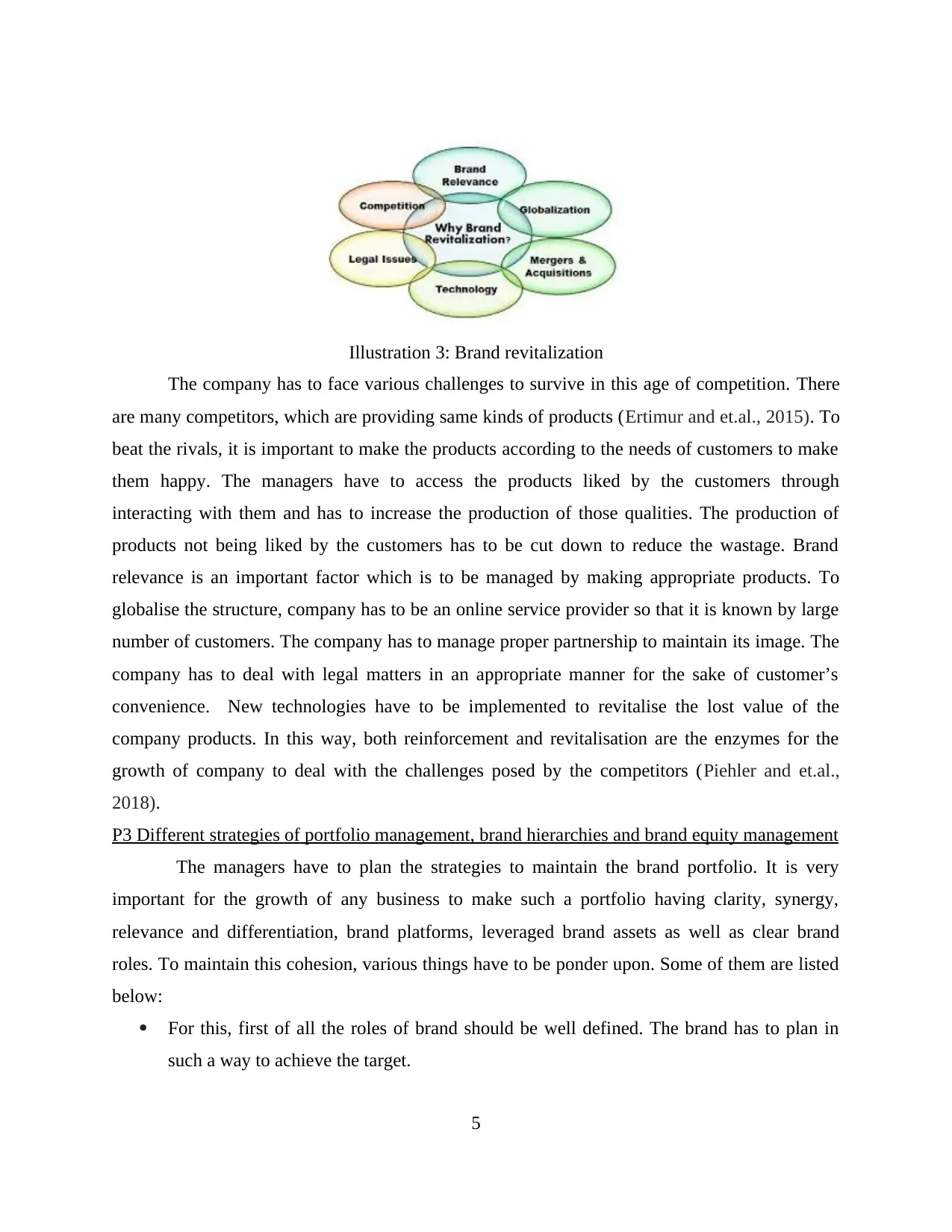
The company has to face various challenges to survive in this age of competition. There
are many competitors, which are providing same kinds of products (Ertimur and et.al., 2015). To
beat the rivals, it is important to make the products according to the needs of customers to make
them happy. The managers have to access the products liked by the customers through
interacting with them and has to increase the production of those qualities. The production of
products not being liked by the customers has to be cut down to reduce the wastage. Brand
relevance is an important factor which is to be managed by making appropriate products. To
globalise the structure, company has to be an online service provider so that it is known by large
number of customers. The company has to manage proper partnership to maintain its image. The
company has to deal with legal matters in an appropriate manner for the sake of customer’s
convenience. New technologies have to be implemented to revitalise the lost value of the
company products. In this way, both reinforcement and revitalisation are the enzymes for the
growth of company to deal with the challenges posed by the competitors (Piehler and et.al.,
2018).
P3 Different strategies of portfolio management, brand hierarchies and brand equity management
The managers have to plan the strategies to maintain the brand portfolio. It is very
important for the growth of any business to make such a portfolio having clarity, synergy,
relevance and differentiation, brand platforms, leveraged brand assets as well as clear brand
roles. To maintain this cohesion, various things have to be ponder upon. Some of them are listed
below:
For this, first of all the roles of brand should be well defined. The brand has to plan in
such a way to achieve the target.
5
Illustration 3: Brand revitalization
are many competitors, which are providing same kinds of products (Ertimur and et.al., 2015). To
beat the rivals, it is important to make the products according to the needs of customers to make
them happy. The managers have to access the products liked by the customers through
interacting with them and has to increase the production of those qualities. The production of
products not being liked by the customers has to be cut down to reduce the wastage. Brand
relevance is an important factor which is to be managed by making appropriate products. To
globalise the structure, company has to be an online service provider so that it is known by large
number of customers. The company has to manage proper partnership to maintain its image. The
company has to deal with legal matters in an appropriate manner for the sake of customer’s
convenience. New technologies have to be implemented to revitalise the lost value of the
company products. In this way, both reinforcement and revitalisation are the enzymes for the
growth of company to deal with the challenges posed by the competitors (Piehler and et.al.,
2018).
P3 Different strategies of portfolio management, brand hierarchies and brand equity management
The managers have to plan the strategies to maintain the brand portfolio. It is very
important for the growth of any business to make such a portfolio having clarity, synergy,
relevance and differentiation, brand platforms, leveraged brand assets as well as clear brand
roles. To maintain this cohesion, various things have to be ponder upon. Some of them are listed
below:
For this, first of all the roles of brand should be well defined. The brand has to plan in
such a way to achieve the target.
5
Illustration 3: Brand revitalization
Paraphrase This Document
Need a fresh take? Get an instant paraphrase of this document with our AI Paraphraser
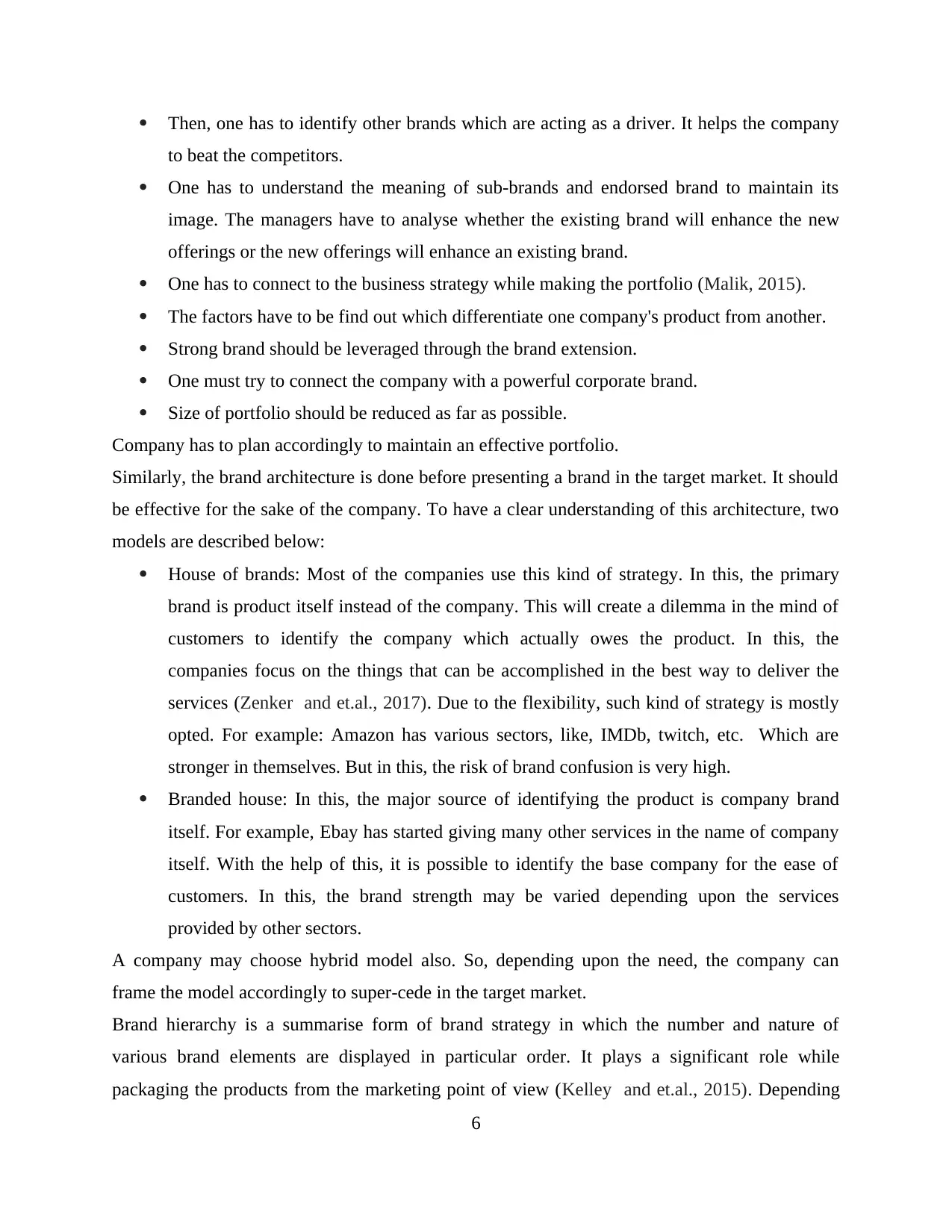
Then, one has to identify other brands which are acting as a driver. It helps the company
to beat the competitors.
One has to understand the meaning of sub-brands and endorsed brand to maintain its
image. The managers have to analyse whether the existing brand will enhance the new
offerings or the new offerings will enhance an existing brand.
One has to connect to the business strategy while making the portfolio (Malik, 2015).
The factors have to be find out which differentiate one company's product from another.
Strong brand should be leveraged through the brand extension.
One must try to connect the company with a powerful corporate brand.
Size of portfolio should be reduced as far as possible.
Company has to plan accordingly to maintain an effective portfolio.
Similarly, the brand architecture is done before presenting a brand in the target market. It should
be effective for the sake of the company. To have a clear understanding of this architecture, two
models are described below:
House of brands: Most of the companies use this kind of strategy. In this, the primary
brand is product itself instead of the company. This will create a dilemma in the mind of
customers to identify the company which actually owes the product. In this, the
companies focus on the things that can be accomplished in the best way to deliver the
services (Zenker and et.al., 2017). Due to the flexibility, such kind of strategy is mostly
opted. For example: Amazon has various sectors, like, IMDb, twitch, etc. Which are
stronger in themselves. But in this, the risk of brand confusion is very high.
Branded house: In this, the major source of identifying the product is company brand
itself. For example, Ebay has started giving many other services in the name of company
itself. With the help of this, it is possible to identify the base company for the ease of
customers. In this, the brand strength may be varied depending upon the services
provided by other sectors.
A company may choose hybrid model also. So, depending upon the need, the company can
frame the model accordingly to super-cede in the target market.
Brand hierarchy is a summarise form of brand strategy in which the number and nature of
various brand elements are displayed in particular order. It plays a significant role while
packaging the products from the marketing point of view (Kelley and et.al., 2015). Depending
6
to beat the competitors.
One has to understand the meaning of sub-brands and endorsed brand to maintain its
image. The managers have to analyse whether the existing brand will enhance the new
offerings or the new offerings will enhance an existing brand.
One has to connect to the business strategy while making the portfolio (Malik, 2015).
The factors have to be find out which differentiate one company's product from another.
Strong brand should be leveraged through the brand extension.
One must try to connect the company with a powerful corporate brand.
Size of portfolio should be reduced as far as possible.
Company has to plan accordingly to maintain an effective portfolio.
Similarly, the brand architecture is done before presenting a brand in the target market. It should
be effective for the sake of the company. To have a clear understanding of this architecture, two
models are described below:
House of brands: Most of the companies use this kind of strategy. In this, the primary
brand is product itself instead of the company. This will create a dilemma in the mind of
customers to identify the company which actually owes the product. In this, the
companies focus on the things that can be accomplished in the best way to deliver the
services (Zenker and et.al., 2017). Due to the flexibility, such kind of strategy is mostly
opted. For example: Amazon has various sectors, like, IMDb, twitch, etc. Which are
stronger in themselves. But in this, the risk of brand confusion is very high.
Branded house: In this, the major source of identifying the product is company brand
itself. For example, Ebay has started giving many other services in the name of company
itself. With the help of this, it is possible to identify the base company for the ease of
customers. In this, the brand strength may be varied depending upon the services
provided by other sectors.
A company may choose hybrid model also. So, depending upon the need, the company can
frame the model accordingly to super-cede in the target market.
Brand hierarchy is a summarise form of brand strategy in which the number and nature of
various brand elements are displayed in particular order. It plays a significant role while
packaging the products from the marketing point of view (Kelley and et.al., 2015). Depending
6
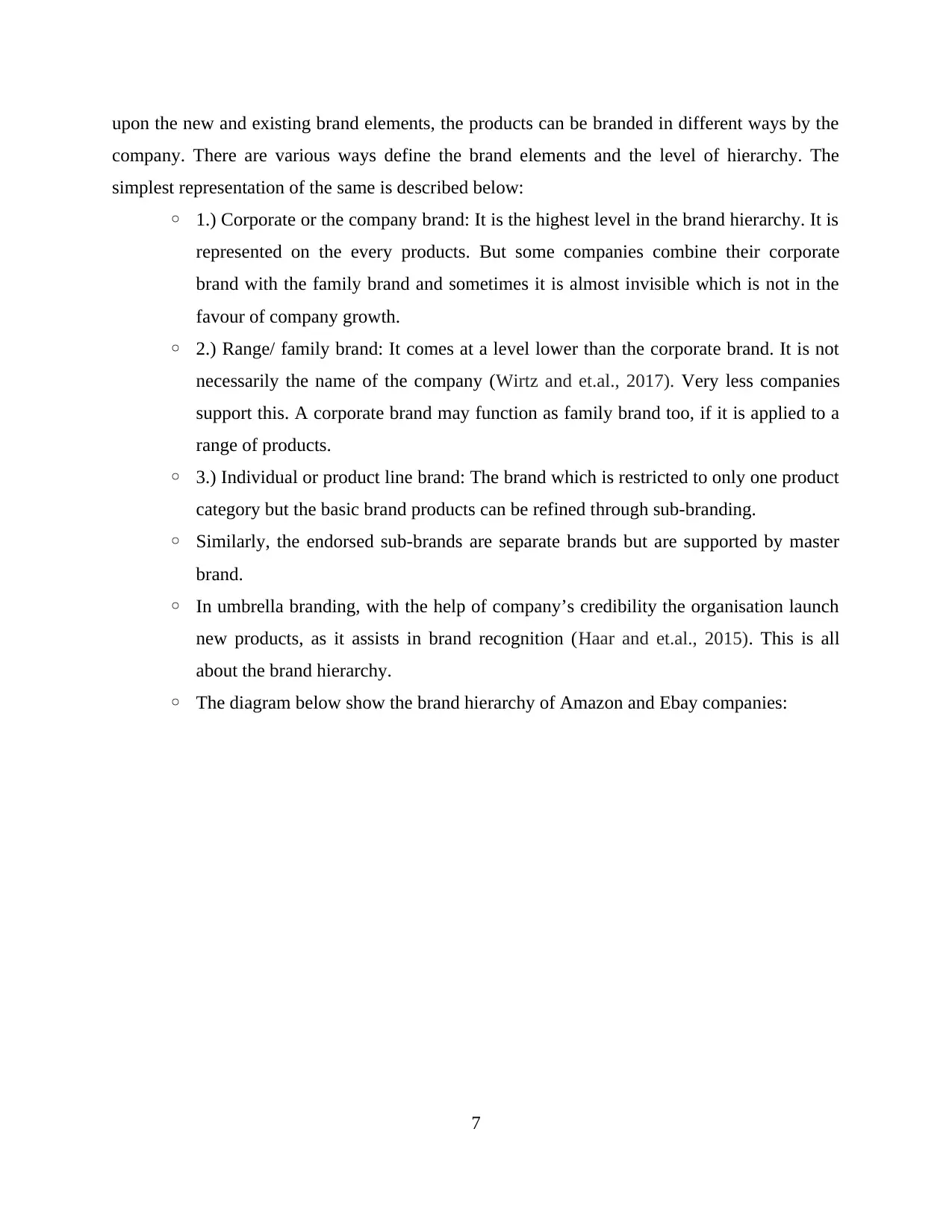
upon the new and existing brand elements, the products can be branded in different ways by the
company. There are various ways define the brand elements and the level of hierarchy. The
simplest representation of the same is described below:
◦ 1.) Corporate or the company brand: It is the highest level in the brand hierarchy. It is
represented on the every products. But some companies combine their corporate
brand with the family brand and sometimes it is almost invisible which is not in the
favour of company growth.
◦ 2.) Range/ family brand: It comes at a level lower than the corporate brand. It is not
necessarily the name of the company (Wirtz and et.al., 2017). Very less companies
support this. A corporate brand may function as family brand too, if it is applied to a
range of products.
◦ 3.) Individual or product line brand: The brand which is restricted to only one product
category but the basic brand products can be refined through sub-branding.
◦ Similarly, the endorsed sub-brands are separate brands but are supported by master
brand.
◦ In umbrella branding, with the help of company’s credibility the organisation launch
new products, as it assists in brand recognition (Haar and et.al., 2015). This is all
about the brand hierarchy.
◦ The diagram below show the brand hierarchy of Amazon and Ebay companies:
7
company. There are various ways define the brand elements and the level of hierarchy. The
simplest representation of the same is described below:
◦ 1.) Corporate or the company brand: It is the highest level in the brand hierarchy. It is
represented on the every products. But some companies combine their corporate
brand with the family brand and sometimes it is almost invisible which is not in the
favour of company growth.
◦ 2.) Range/ family brand: It comes at a level lower than the corporate brand. It is not
necessarily the name of the company (Wirtz and et.al., 2017). Very less companies
support this. A corporate brand may function as family brand too, if it is applied to a
range of products.
◦ 3.) Individual or product line brand: The brand which is restricted to only one product
category but the basic brand products can be refined through sub-branding.
◦ Similarly, the endorsed sub-brands are separate brands but are supported by master
brand.
◦ In umbrella branding, with the help of company’s credibility the organisation launch
new products, as it assists in brand recognition (Haar and et.al., 2015). This is all
about the brand hierarchy.
◦ The diagram below show the brand hierarchy of Amazon and Ebay companies:
7
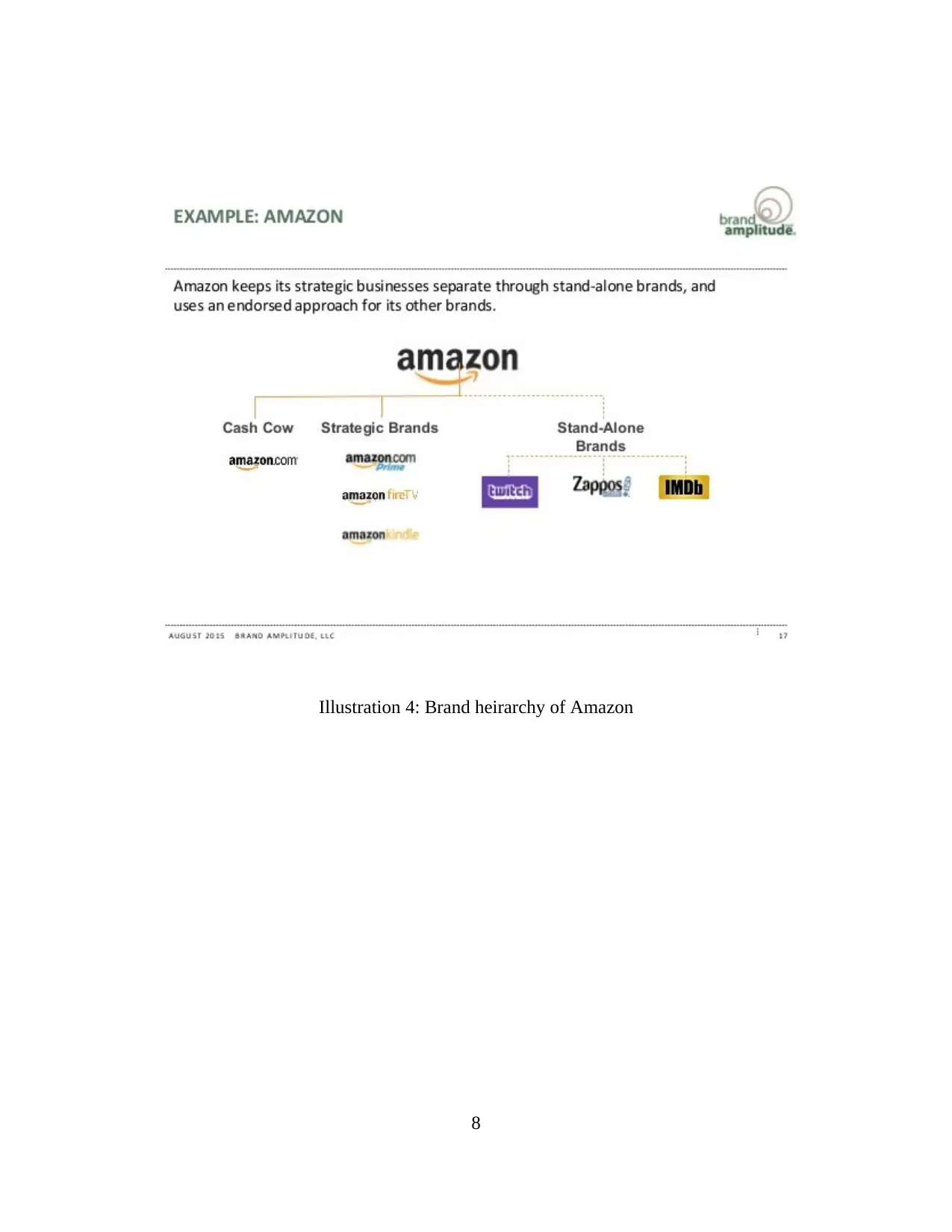
8
Illustration 4: Brand heirarchy of Amazon
Illustration 4: Brand heirarchy of Amazon
Secure Best Marks with AI Grader
Need help grading? Try our AI Grader for instant feedback on your assignments.
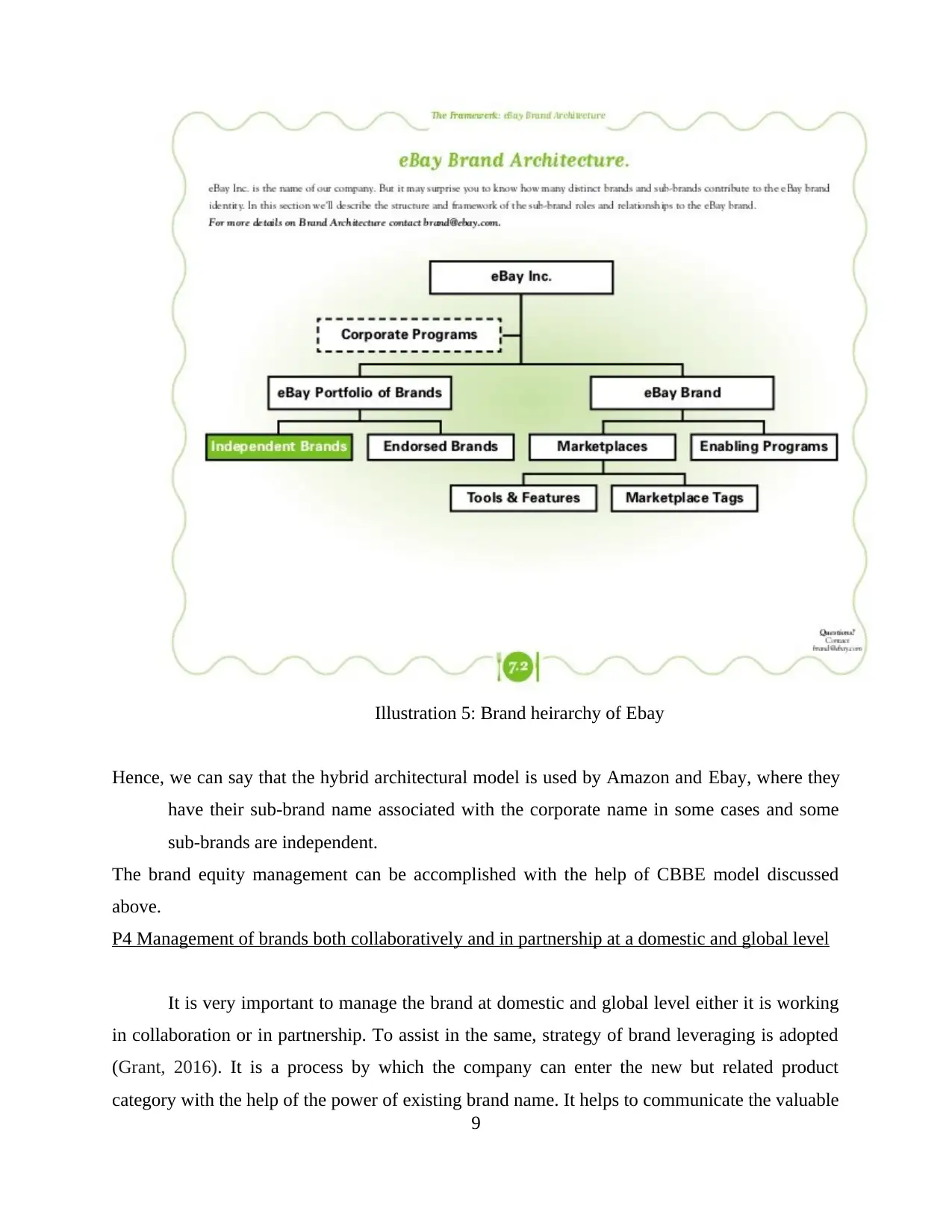
Hence, we can say that the hybrid architectural model is used by Amazon and Ebay, where they
have their sub-brand name associated with the corporate name in some cases and some
sub-brands are independent.
The brand equity management can be accomplished with the help of CBBE model discussed
above.
P4 Management of brands both collaboratively and in partnership at a domestic and global level
It is very important to manage the brand at domestic and global level either it is working
in collaboration or in partnership. To assist in the same, strategy of brand leveraging is adopted
(Grant, 2016). It is a process by which the company can enter the new but related product
category with the help of the power of existing brand name. It helps to communicate the valuable
9
Illustration 5: Brand heirarchy of Ebay
have their sub-brand name associated with the corporate name in some cases and some
sub-brands are independent.
The brand equity management can be accomplished with the help of CBBE model discussed
above.
P4 Management of brands both collaboratively and in partnership at a domestic and global level
It is very important to manage the brand at domestic and global level either it is working
in collaboration or in partnership. To assist in the same, strategy of brand leveraging is adopted
(Grant, 2016). It is a process by which the company can enter the new but related product
category with the help of the power of existing brand name. It helps to communicate the valuable
9
Illustration 5: Brand heirarchy of Ebay
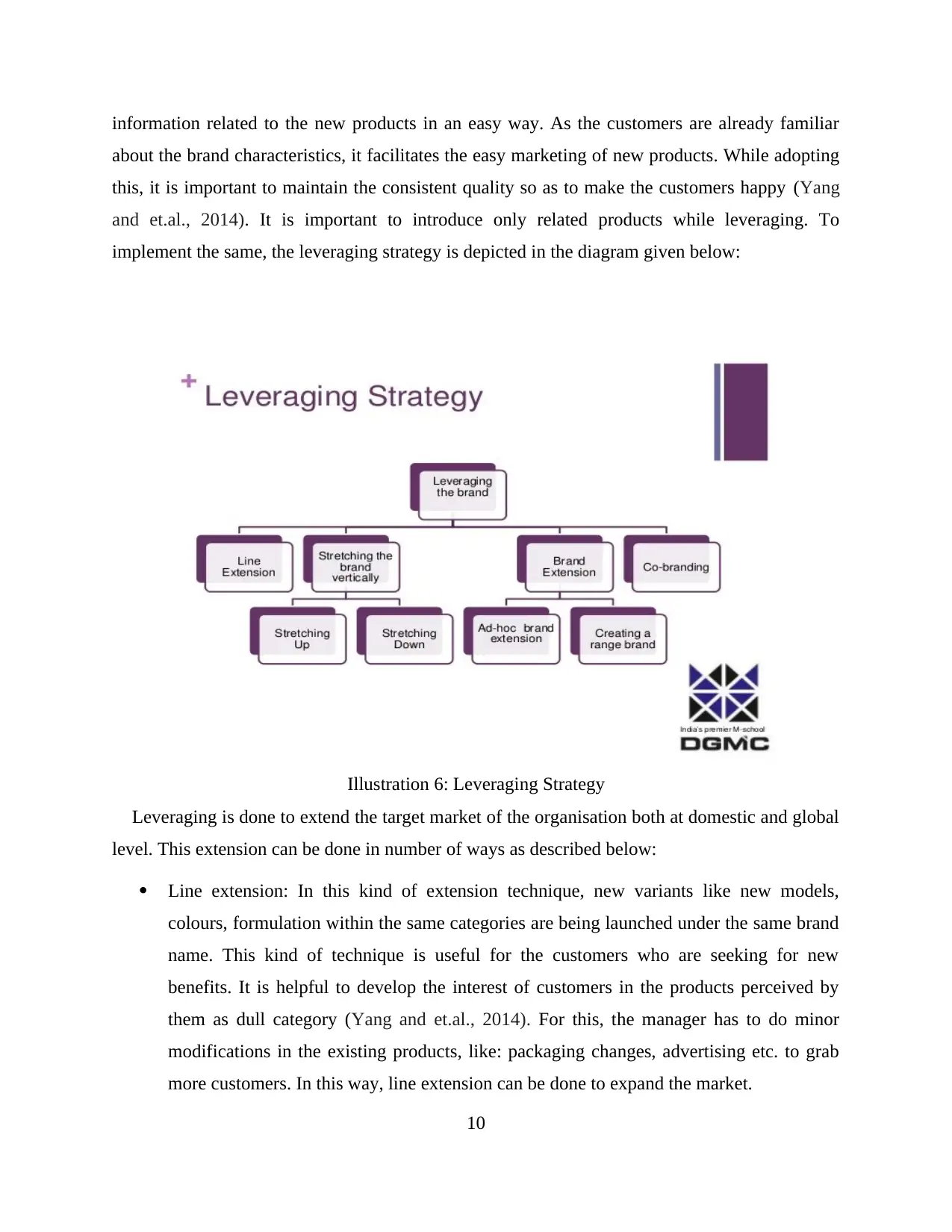
information related to the new products in an easy way. As the customers are already familiar
about the brand characteristics, it facilitates the easy marketing of new products. While adopting
this, it is important to maintain the consistent quality so as to make the customers happy (Yang
and et.al., 2014). It is important to introduce only related products while leveraging. To
implement the same, the leveraging strategy is depicted in the diagram given below:
Leveraging is done to extend the target market of the organisation both at domestic and global
level. This extension can be done in number of ways as described below:
Line extension: In this kind of extension technique, new variants like new models,
colours, formulation within the same categories are being launched under the same brand
name. This kind of technique is useful for the customers who are seeking for new
benefits. It is helpful to develop the interest of customers in the products perceived by
them as dull category (Yang and et.al., 2014). For this, the manager has to do minor
modifications in the existing products, like: packaging changes, advertising etc. to grab
more customers. In this way, line extension can be done to expand the market.
10
Illustration 6: Leveraging Strategy
about the brand characteristics, it facilitates the easy marketing of new products. While adopting
this, it is important to maintain the consistent quality so as to make the customers happy (Yang
and et.al., 2014). It is important to introduce only related products while leveraging. To
implement the same, the leveraging strategy is depicted in the diagram given below:
Leveraging is done to extend the target market of the organisation both at domestic and global
level. This extension can be done in number of ways as described below:
Line extension: In this kind of extension technique, new variants like new models,
colours, formulation within the same categories are being launched under the same brand
name. This kind of technique is useful for the customers who are seeking for new
benefits. It is helpful to develop the interest of customers in the products perceived by
them as dull category (Yang and et.al., 2014). For this, the manager has to do minor
modifications in the existing products, like: packaging changes, advertising etc. to grab
more customers. In this way, line extension can be done to expand the market.
10
Illustration 6: Leveraging Strategy
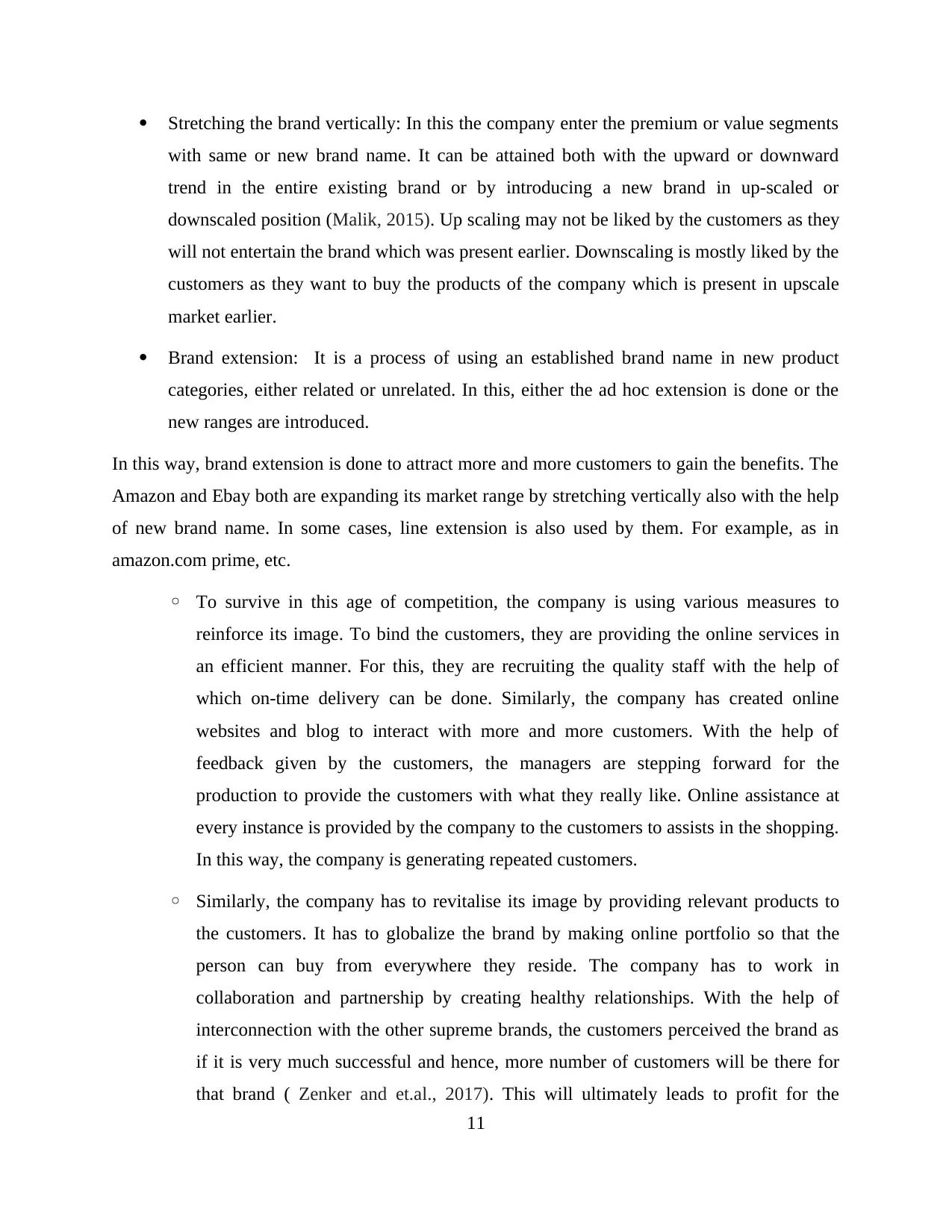
Stretching the brand vertically: In this the company enter the premium or value segments
with same or new brand name. It can be attained both with the upward or downward
trend in the entire existing brand or by introducing a new brand in up-scaled or
downscaled position (Malik, 2015). Up scaling may not be liked by the customers as they
will not entertain the brand which was present earlier. Downscaling is mostly liked by the
customers as they want to buy the products of the company which is present in upscale
market earlier.
Brand extension: It is a process of using an established brand name in new product
categories, either related or unrelated. In this, either the ad hoc extension is done or the
new ranges are introduced.
In this way, brand extension is done to attract more and more customers to gain the benefits. The
Amazon and Ebay both are expanding its market range by stretching vertically also with the help
of new brand name. In some cases, line extension is also used by them. For example, as in
amazon.com prime, etc.
◦ To survive in this age of competition, the company is using various measures to
reinforce its image. To bind the customers, they are providing the online services in
an efficient manner. For this, they are recruiting the quality staff with the help of
which on-time delivery can be done. Similarly, the company has created online
websites and blog to interact with more and more customers. With the help of
feedback given by the customers, the managers are stepping forward for the
production to provide the customers with what they really like. Online assistance at
every instance is provided by the company to the customers to assists in the shopping.
In this way, the company is generating repeated customers.
◦ Similarly, the company has to revitalise its image by providing relevant products to
the customers. It has to globalize the brand by making online portfolio so that the
person can buy from everywhere they reside. The company has to work in
collaboration and partnership by creating healthy relationships. With the help of
interconnection with the other supreme brands, the customers perceived the brand as
if it is very much successful and hence, more number of customers will be there for
that brand ( Zenker and et.al., 2017). This will ultimately leads to profit for the
11
with same or new brand name. It can be attained both with the upward or downward
trend in the entire existing brand or by introducing a new brand in up-scaled or
downscaled position (Malik, 2015). Up scaling may not be liked by the customers as they
will not entertain the brand which was present earlier. Downscaling is mostly liked by the
customers as they want to buy the products of the company which is present in upscale
market earlier.
Brand extension: It is a process of using an established brand name in new product
categories, either related or unrelated. In this, either the ad hoc extension is done or the
new ranges are introduced.
In this way, brand extension is done to attract more and more customers to gain the benefits. The
Amazon and Ebay both are expanding its market range by stretching vertically also with the help
of new brand name. In some cases, line extension is also used by them. For example, as in
amazon.com prime, etc.
◦ To survive in this age of competition, the company is using various measures to
reinforce its image. To bind the customers, they are providing the online services in
an efficient manner. For this, they are recruiting the quality staff with the help of
which on-time delivery can be done. Similarly, the company has created online
websites and blog to interact with more and more customers. With the help of
feedback given by the customers, the managers are stepping forward for the
production to provide the customers with what they really like. Online assistance at
every instance is provided by the company to the customers to assists in the shopping.
In this way, the company is generating repeated customers.
◦ Similarly, the company has to revitalise its image by providing relevant products to
the customers. It has to globalize the brand by making online portfolio so that the
person can buy from everywhere they reside. The company has to work in
collaboration and partnership by creating healthy relationships. With the help of
interconnection with the other supreme brands, the customers perceived the brand as
if it is very much successful and hence, more number of customers will be there for
that brand ( Zenker and et.al., 2017). This will ultimately leads to profit for the
11
Paraphrase This Document
Need a fresh take? Get an instant paraphrase of this document with our AI Paraphraser
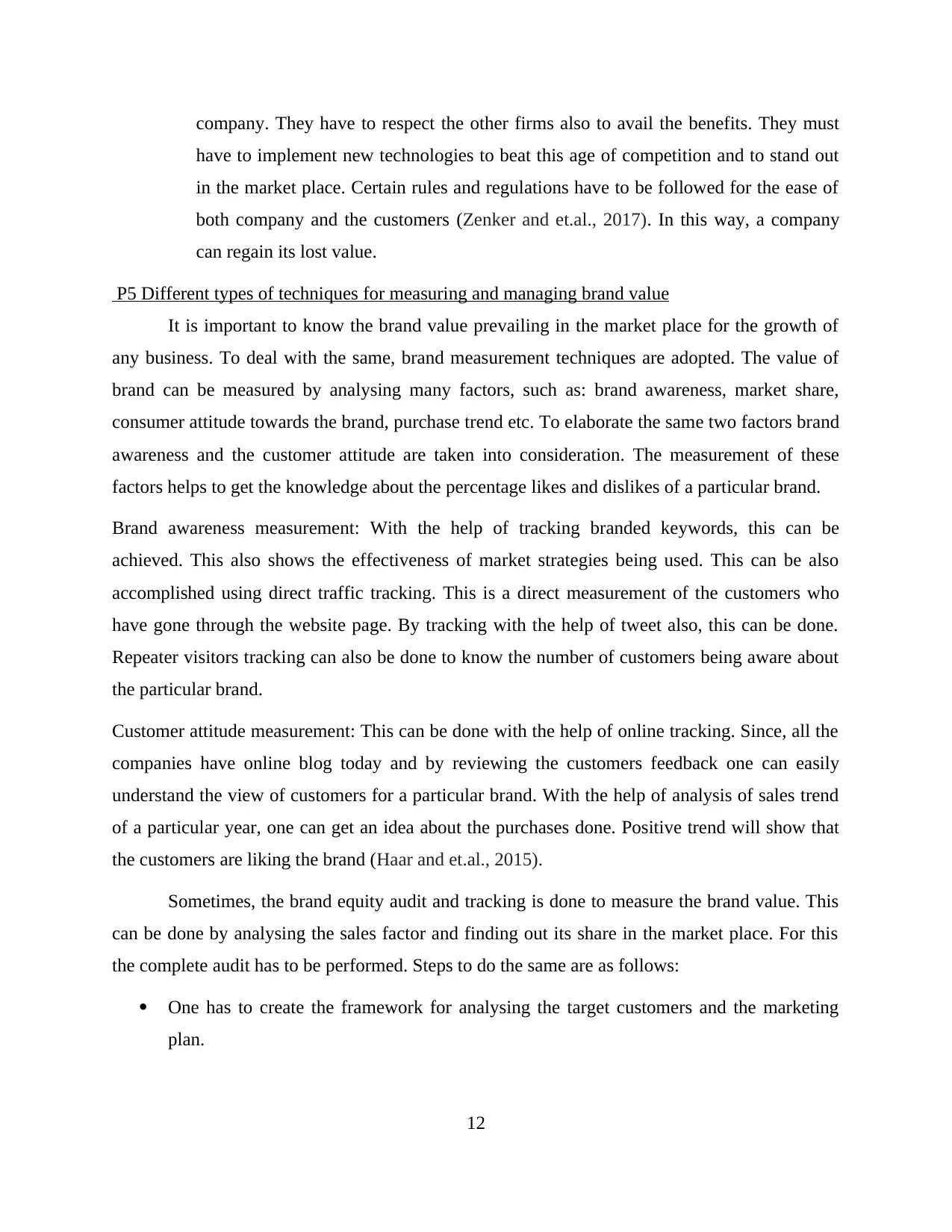
company. They have to respect the other firms also to avail the benefits. They must
have to implement new technologies to beat this age of competition and to stand out
in the market place. Certain rules and regulations have to be followed for the ease of
both company and the customers (Zenker and et.al., 2017). In this way, a company
can regain its lost value.
P5 Different types of techniques for measuring and managing brand value
It is important to know the brand value prevailing in the market place for the growth of
any business. To deal with the same, brand measurement techniques are adopted. The value of
brand can be measured by analysing many factors, such as: brand awareness, market share,
consumer attitude towards the brand, purchase trend etc. To elaborate the same two factors brand
awareness and the customer attitude are taken into consideration. The measurement of these
factors helps to get the knowledge about the percentage likes and dislikes of a particular brand.
Brand awareness measurement: With the help of tracking branded keywords, this can be
achieved. This also shows the effectiveness of market strategies being used. This can be also
accomplished using direct traffic tracking. This is a direct measurement of the customers who
have gone through the website page. By tracking with the help of tweet also, this can be done.
Repeater visitors tracking can also be done to know the number of customers being aware about
the particular brand.
Customer attitude measurement: This can be done with the help of online tracking. Since, all the
companies have online blog today and by reviewing the customers feedback one can easily
understand the view of customers for a particular brand. With the help of analysis of sales trend
of a particular year, one can get an idea about the purchases done. Positive trend will show that
the customers are liking the brand (Haar and et.al., 2015).
Sometimes, the brand equity audit and tracking is done to measure the brand value. This
can be done by analysing the sales factor and finding out its share in the market place. For this
the complete audit has to be performed. Steps to do the same are as follows:
One has to create the framework for analysing the target customers and the marketing
plan.
12
have to implement new technologies to beat this age of competition and to stand out
in the market place. Certain rules and regulations have to be followed for the ease of
both company and the customers (Zenker and et.al., 2017). In this way, a company
can regain its lost value.
P5 Different types of techniques for measuring and managing brand value
It is important to know the brand value prevailing in the market place for the growth of
any business. To deal with the same, brand measurement techniques are adopted. The value of
brand can be measured by analysing many factors, such as: brand awareness, market share,
consumer attitude towards the brand, purchase trend etc. To elaborate the same two factors brand
awareness and the customer attitude are taken into consideration. The measurement of these
factors helps to get the knowledge about the percentage likes and dislikes of a particular brand.
Brand awareness measurement: With the help of tracking branded keywords, this can be
achieved. This also shows the effectiveness of market strategies being used. This can be also
accomplished using direct traffic tracking. This is a direct measurement of the customers who
have gone through the website page. By tracking with the help of tweet also, this can be done.
Repeater visitors tracking can also be done to know the number of customers being aware about
the particular brand.
Customer attitude measurement: This can be done with the help of online tracking. Since, all the
companies have online blog today and by reviewing the customers feedback one can easily
understand the view of customers for a particular brand. With the help of analysis of sales trend
of a particular year, one can get an idea about the purchases done. Positive trend will show that
the customers are liking the brand (Haar and et.al., 2015).
Sometimes, the brand equity audit and tracking is done to measure the brand value. This
can be done by analysing the sales factor and finding out its share in the market place. For this
the complete audit has to be performed. Steps to do the same are as follows:
One has to create the framework for analysing the target customers and the marketing
plan.
12
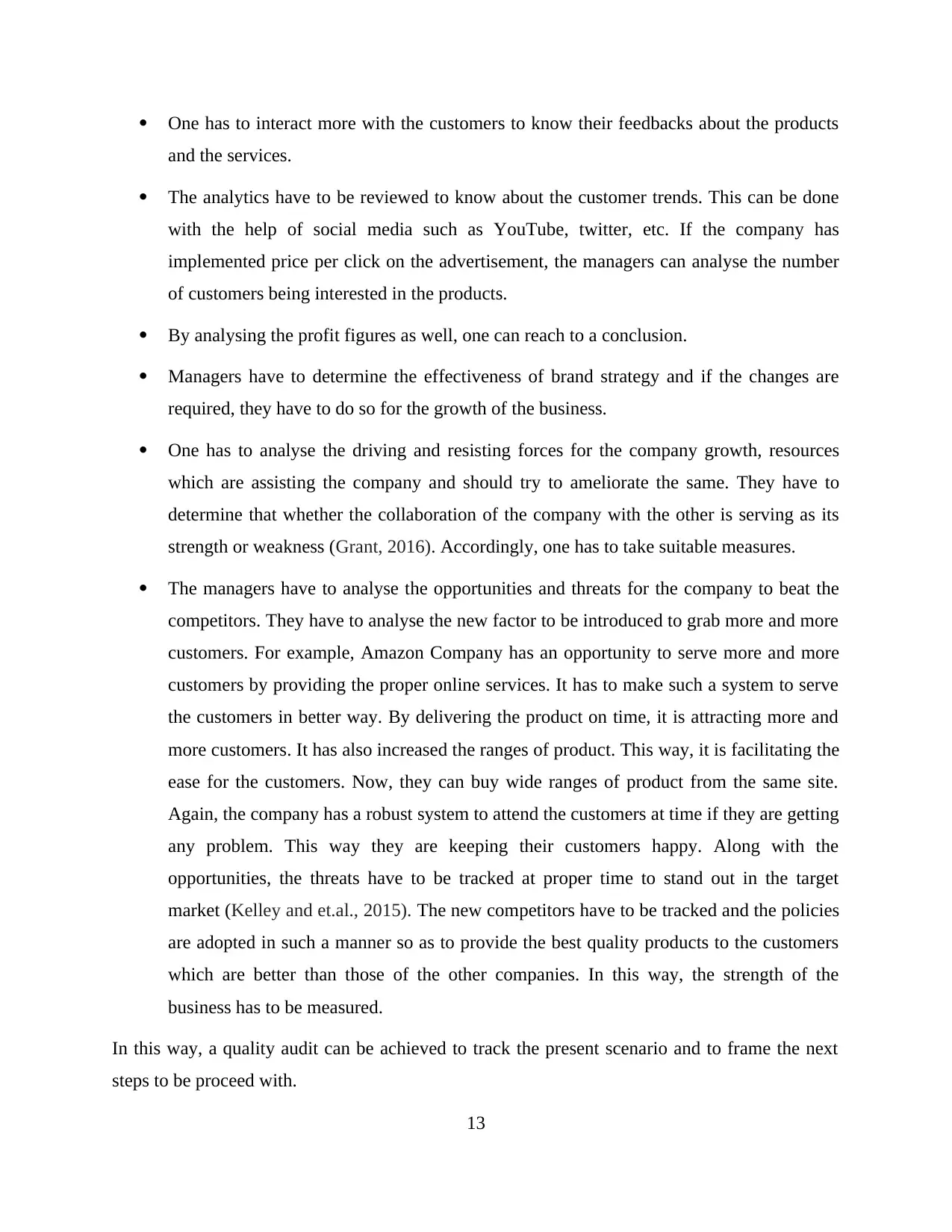
One has to interact more with the customers to know their feedbacks about the products
and the services.
The analytics have to be reviewed to know about the customer trends. This can be done
with the help of social media such as YouTube, twitter, etc. If the company has
implemented price per click on the advertisement, the managers can analyse the number
of customers being interested in the products.
By analysing the profit figures as well, one can reach to a conclusion.
Managers have to determine the effectiveness of brand strategy and if the changes are
required, they have to do so for the growth of the business.
One has to analyse the driving and resisting forces for the company growth, resources
which are assisting the company and should try to ameliorate the same. They have to
determine that whether the collaboration of the company with the other is serving as its
strength or weakness (Grant, 2016). Accordingly, one has to take suitable measures.
The managers have to analyse the opportunities and threats for the company to beat the
competitors. They have to analyse the new factor to be introduced to grab more and more
customers. For example, Amazon Company has an opportunity to serve more and more
customers by providing the proper online services. It has to make such a system to serve
the customers in better way. By delivering the product on time, it is attracting more and
more customers. It has also increased the ranges of product. This way, it is facilitating the
ease for the customers. Now, they can buy wide ranges of product from the same site.
Again, the company has a robust system to attend the customers at time if they are getting
any problem. This way they are keeping their customers happy. Along with the
opportunities, the threats have to be tracked at proper time to stand out in the target
market (Kelley and et.al., 2015). The new competitors have to be tracked and the policies
are adopted in such a manner so as to provide the best quality products to the customers
which are better than those of the other companies. In this way, the strength of the
business has to be measured.
In this way, a quality audit can be achieved to track the present scenario and to frame the next
steps to be proceed with.
13
and the services.
The analytics have to be reviewed to know about the customer trends. This can be done
with the help of social media such as YouTube, twitter, etc. If the company has
implemented price per click on the advertisement, the managers can analyse the number
of customers being interested in the products.
By analysing the profit figures as well, one can reach to a conclusion.
Managers have to determine the effectiveness of brand strategy and if the changes are
required, they have to do so for the growth of the business.
One has to analyse the driving and resisting forces for the company growth, resources
which are assisting the company and should try to ameliorate the same. They have to
determine that whether the collaboration of the company with the other is serving as its
strength or weakness (Grant, 2016). Accordingly, one has to take suitable measures.
The managers have to analyse the opportunities and threats for the company to beat the
competitors. They have to analyse the new factor to be introduced to grab more and more
customers. For example, Amazon Company has an opportunity to serve more and more
customers by providing the proper online services. It has to make such a system to serve
the customers in better way. By delivering the product on time, it is attracting more and
more customers. It has also increased the ranges of product. This way, it is facilitating the
ease for the customers. Now, they can buy wide ranges of product from the same site.
Again, the company has a robust system to attend the customers at time if they are getting
any problem. This way they are keeping their customers happy. Along with the
opportunities, the threats have to be tracked at proper time to stand out in the target
market (Kelley and et.al., 2015). The new competitors have to be tracked and the policies
are adopted in such a manner so as to provide the best quality products to the customers
which are better than those of the other companies. In this way, the strength of the
business has to be measured.
In this way, a quality audit can be achieved to track the present scenario and to frame the next
steps to be proceed with.
13
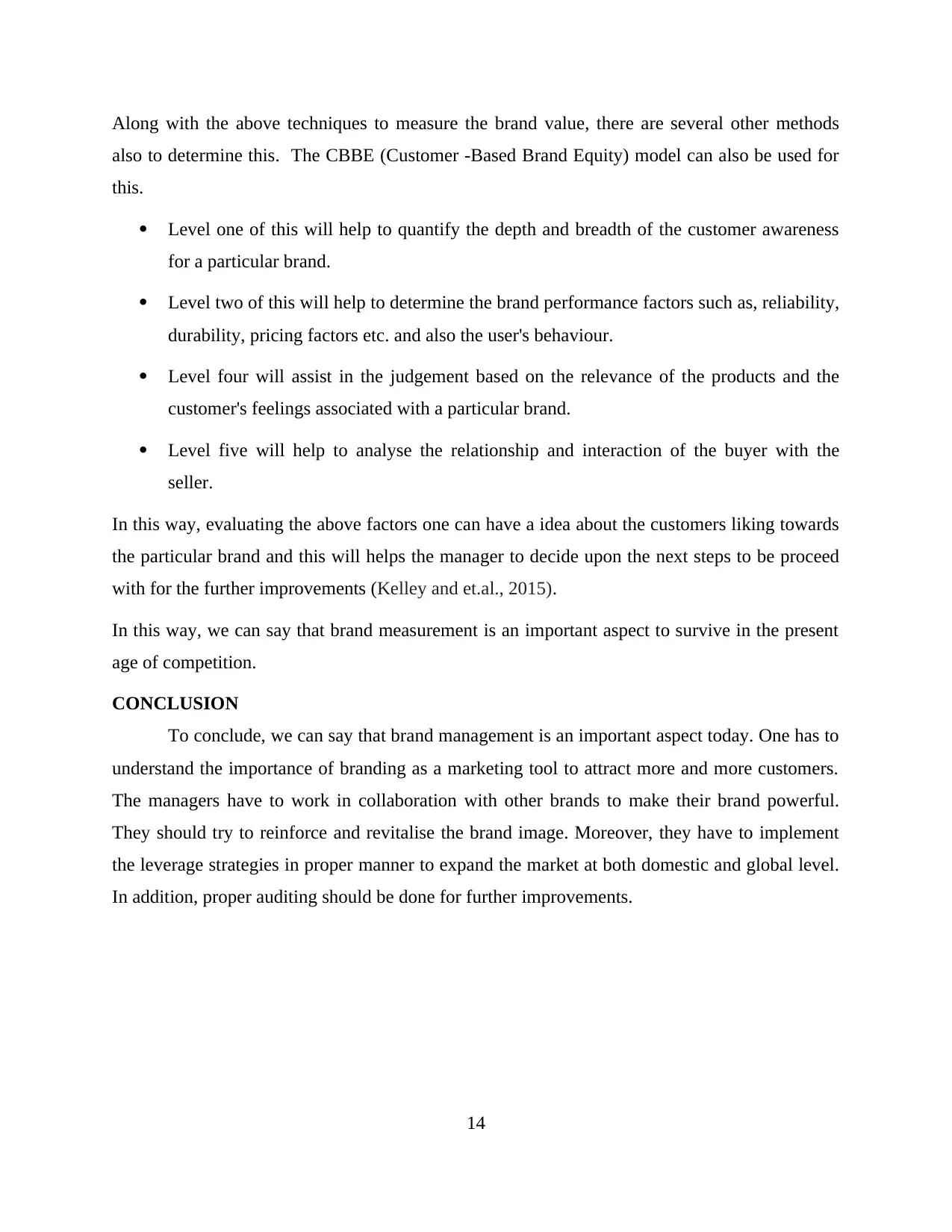
Along with the above techniques to measure the brand value, there are several other methods
also to determine this. The CBBE (Customer -Based Brand Equity) model can also be used for
this.
Level one of this will help to quantify the depth and breadth of the customer awareness
for a particular brand.
Level two of this will help to determine the brand performance factors such as, reliability,
durability, pricing factors etc. and also the user's behaviour.
Level four will assist in the judgement based on the relevance of the products and the
customer's feelings associated with a particular brand.
Level five will help to analyse the relationship and interaction of the buyer with the
seller.
In this way, evaluating the above factors one can have a idea about the customers liking towards
the particular brand and this will helps the manager to decide upon the next steps to be proceed
with for the further improvements (Kelley and et.al., 2015).
In this way, we can say that brand measurement is an important aspect to survive in the present
age of competition.
CONCLUSION
To conclude, we can say that brand management is an important aspect today. One has to
understand the importance of branding as a marketing tool to attract more and more customers.
The managers have to work in collaboration with other brands to make their brand powerful.
They should try to reinforce and revitalise the brand image. Moreover, they have to implement
the leverage strategies in proper manner to expand the market at both domestic and global level.
In addition, proper auditing should be done for further improvements.
14
also to determine this. The CBBE (Customer -Based Brand Equity) model can also be used for
this.
Level one of this will help to quantify the depth and breadth of the customer awareness
for a particular brand.
Level two of this will help to determine the brand performance factors such as, reliability,
durability, pricing factors etc. and also the user's behaviour.
Level four will assist in the judgement based on the relevance of the products and the
customer's feelings associated with a particular brand.
Level five will help to analyse the relationship and interaction of the buyer with the
seller.
In this way, evaluating the above factors one can have a idea about the customers liking towards
the particular brand and this will helps the manager to decide upon the next steps to be proceed
with for the further improvements (Kelley and et.al., 2015).
In this way, we can say that brand measurement is an important aspect to survive in the present
age of competition.
CONCLUSION
To conclude, we can say that brand management is an important aspect today. One has to
understand the importance of branding as a marketing tool to attract more and more customers.
The managers have to work in collaboration with other brands to make their brand powerful.
They should try to reinforce and revitalise the brand image. Moreover, they have to implement
the leverage strategies in proper manner to expand the market at both domestic and global level.
In addition, proper auditing should be done for further improvements.
14
Secure Best Marks with AI Grader
Need help grading? Try our AI Grader for instant feedback on your assignments.
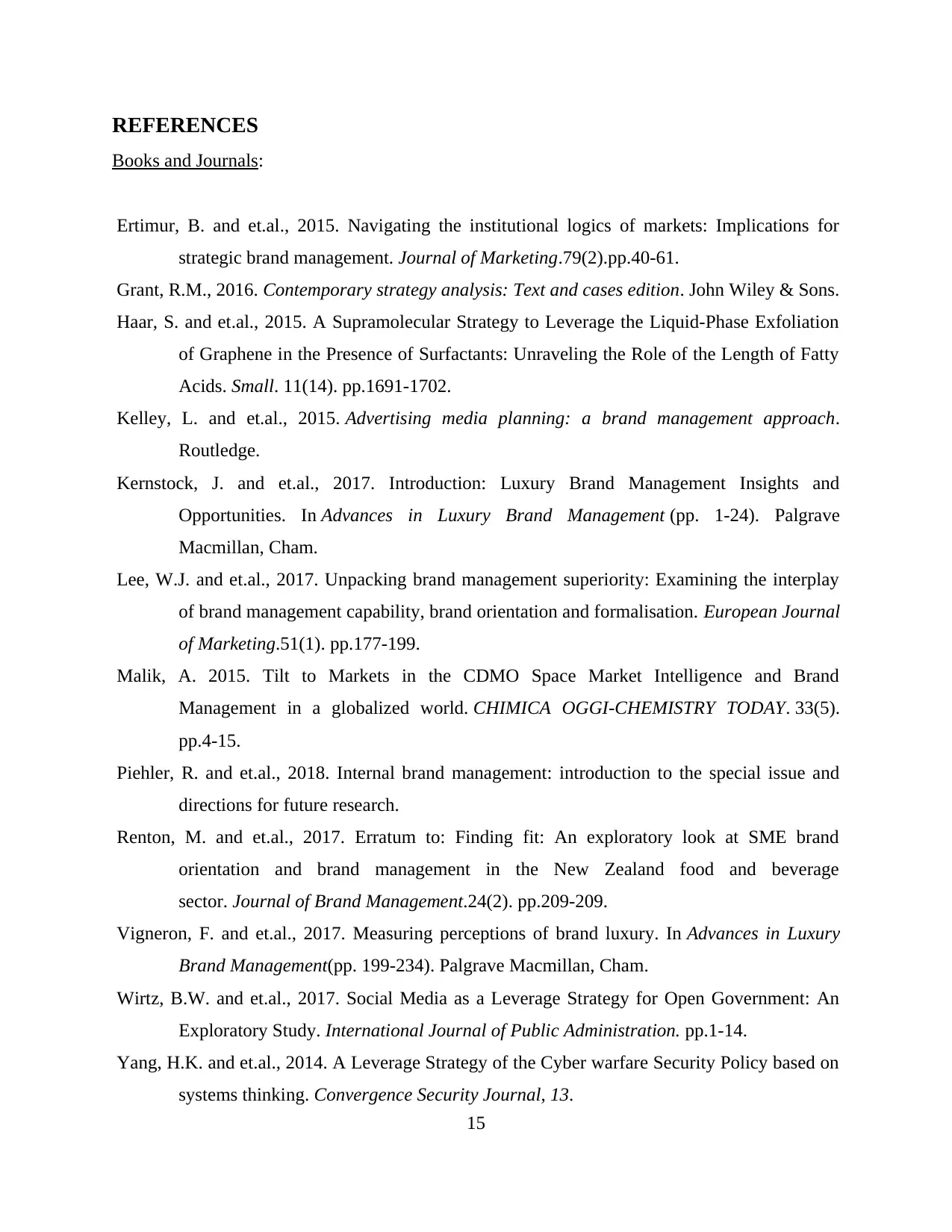
REFERENCES
Books and Journals:
Ertimur, B. and et.al., 2015. Navigating the institutional logics of markets: Implications for
strategic brand management. Journal of Marketing.79(2).pp.40-61.
Grant, R.M., 2016. Contemporary strategy analysis: Text and cases edition. John Wiley & Sons.
Haar, S. and et.al., 2015. A Supramolecular Strategy to Leverage the Liquid‐Phase Exfoliation
of Graphene in the Presence of Surfactants: Unraveling the Role of the Length of Fatty
Acids. Small. 11(14). pp.1691-1702.
Kelley, L. and et.al., 2015. Advertising media planning: a brand management approach.
Routledge.
Kernstock, J. and et.al., 2017. Introduction: Luxury Brand Management Insights and
Opportunities. In Advances in Luxury Brand Management (pp. 1-24). Palgrave
Macmillan, Cham.
Lee, W.J. and et.al., 2017. Unpacking brand management superiority: Examining the interplay
of brand management capability, brand orientation and formalisation. European Journal
of Marketing.51(1). pp.177-199.
Malik, A. 2015. Tilt to Markets in the CDMO Space Market Intelligence and Brand
Management in a globalized world. CHIMICA OGGI-CHEMISTRY TODAY. 33(5).
pp.4-15.
Piehler, R. and et.al., 2018. Internal brand management: introduction to the special issue and
directions for future research.
Renton, M. and et.al., 2017. Erratum to: Finding fit: An exploratory look at SME brand
orientation and brand management in the New Zealand food and beverage
sector. Journal of Brand Management.24(2). pp.209-209.
Vigneron, F. and et.al., 2017. Measuring perceptions of brand luxury. In Advances in Luxury
Brand Management(pp. 199-234). Palgrave Macmillan, Cham.
Wirtz, B.W. and et.al., 2017. Social Media as a Leverage Strategy for Open Government: An
Exploratory Study. International Journal of Public Administration. pp.1-14.
Yang, H.K. and et.al., 2014. A Leverage Strategy of the Cyber warfare Security Policy based on
systems thinking. Convergence Security Journal, 13.
15
Books and Journals:
Ertimur, B. and et.al., 2015. Navigating the institutional logics of markets: Implications for
strategic brand management. Journal of Marketing.79(2).pp.40-61.
Grant, R.M., 2016. Contemporary strategy analysis: Text and cases edition. John Wiley & Sons.
Haar, S. and et.al., 2015. A Supramolecular Strategy to Leverage the Liquid‐Phase Exfoliation
of Graphene in the Presence of Surfactants: Unraveling the Role of the Length of Fatty
Acids. Small. 11(14). pp.1691-1702.
Kelley, L. and et.al., 2015. Advertising media planning: a brand management approach.
Routledge.
Kernstock, J. and et.al., 2017. Introduction: Luxury Brand Management Insights and
Opportunities. In Advances in Luxury Brand Management (pp. 1-24). Palgrave
Macmillan, Cham.
Lee, W.J. and et.al., 2017. Unpacking brand management superiority: Examining the interplay
of brand management capability, brand orientation and formalisation. European Journal
of Marketing.51(1). pp.177-199.
Malik, A. 2015. Tilt to Markets in the CDMO Space Market Intelligence and Brand
Management in a globalized world. CHIMICA OGGI-CHEMISTRY TODAY. 33(5).
pp.4-15.
Piehler, R. and et.al., 2018. Internal brand management: introduction to the special issue and
directions for future research.
Renton, M. and et.al., 2017. Erratum to: Finding fit: An exploratory look at SME brand
orientation and brand management in the New Zealand food and beverage
sector. Journal of Brand Management.24(2). pp.209-209.
Vigneron, F. and et.al., 2017. Measuring perceptions of brand luxury. In Advances in Luxury
Brand Management(pp. 199-234). Palgrave Macmillan, Cham.
Wirtz, B.W. and et.al., 2017. Social Media as a Leverage Strategy for Open Government: An
Exploratory Study. International Journal of Public Administration. pp.1-14.
Yang, H.K. and et.al., 2014. A Leverage Strategy of the Cyber warfare Security Policy based on
systems thinking. Convergence Security Journal, 13.
15
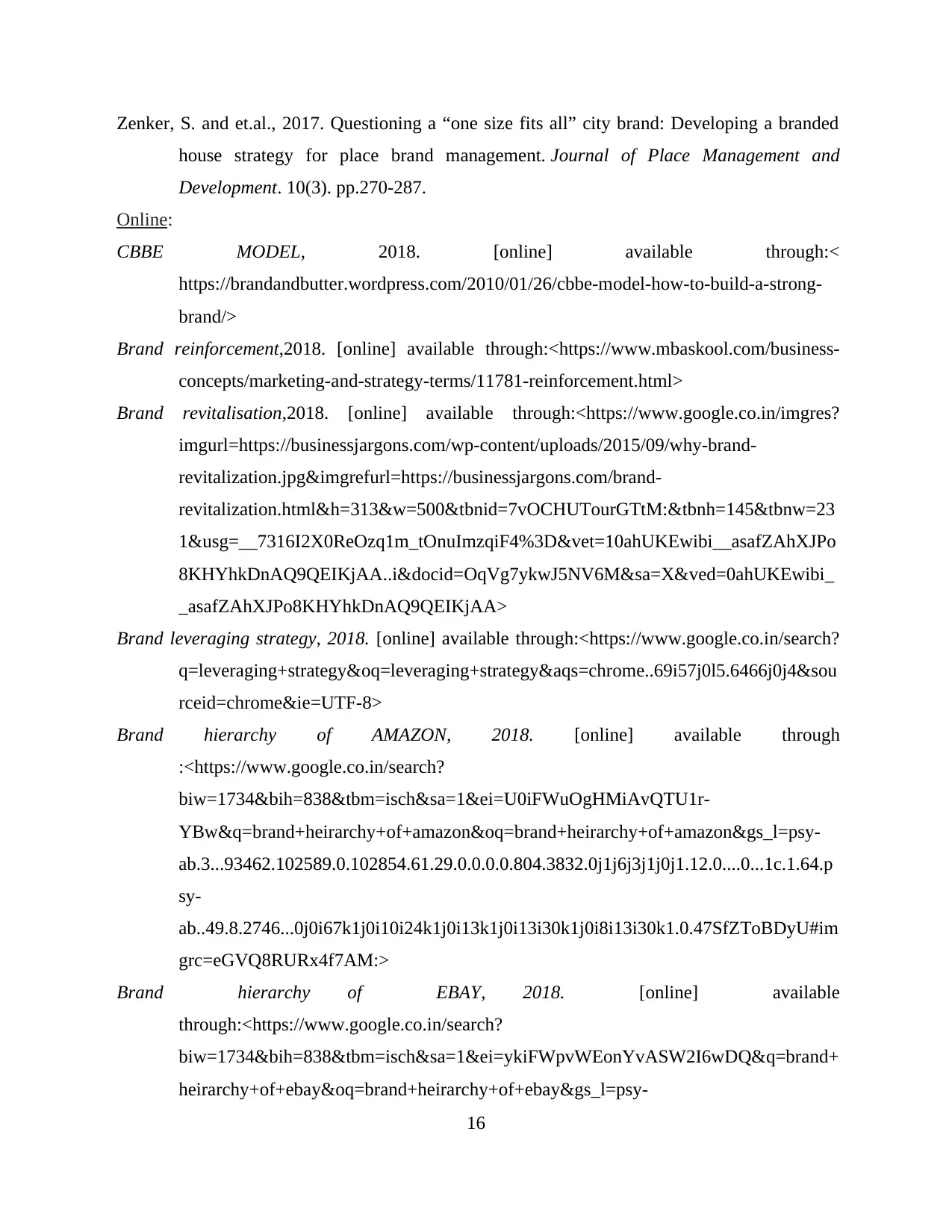
Zenker, S. and et.al., 2017. Questioning a “one size fits all” city brand: Developing a branded
house strategy for place brand management. Journal of Place Management and
Development. 10(3). pp.270-287.
Online:
CBBE MODEL, 2018. [online] available through:<
https://brandandbutter.wordpress.com/2010/01/26/cbbe-model-how-to-build-a-strong-
brand/>
Brand reinforcement,2018. [online] available through:<https://www.mbaskool.com/business-
concepts/marketing-and-strategy-terms/11781-reinforcement.html>
Brand revitalisation,2018. [online] available through:<https://www.google.co.in/imgres?
imgurl=https://businessjargons.com/wp-content/uploads/2015/09/why-brand-
revitalization.jpg&imgrefurl=https://businessjargons.com/brand-
revitalization.html&h=313&w=500&tbnid=7vOCHUTourGTtM:&tbnh=145&tbnw=23
1&usg=__7316I2X0ReOzq1m_tOnuImzqiF4%3D&vet=10ahUKEwibi__asafZAhXJPo
8KHYhkDnAQ9QEIKjAA..i&docid=OqVg7ykwJ5NV6M&sa=X&ved=0ahUKEwibi_
_asafZAhXJPo8KHYhkDnAQ9QEIKjAA>
Brand leveraging strategy, 2018. [online] available through:<https://www.google.co.in/search?
q=leveraging+strategy&oq=leveraging+strategy&aqs=chrome..69i57j0l5.6466j0j4&sou
rceid=chrome&ie=UTF-8>
Brand hierarchy of AMAZON, 2018. [online] available through
:<https://www.google.co.in/search?
biw=1734&bih=838&tbm=isch&sa=1&ei=U0iFWuOgHMiAvQTU1r-
YBw&q=brand+heirarchy+of+amazon&oq=brand+heirarchy+of+amazon&gs_l=psy-
ab.3...93462.102589.0.102854.61.29.0.0.0.0.804.3832.0j1j6j3j1j0j1.12.0....0...1c.1.64.p
sy-
ab..49.8.2746...0j0i67k1j0i10i24k1j0i13k1j0i13i30k1j0i8i13i30k1.0.47SfZToBDyU#im
grc=eGVQ8RURx4f7AM:>
Brand hierarchy of EBAY, 2018. [online] available
through:<https://www.google.co.in/search?
biw=1734&bih=838&tbm=isch&sa=1&ei=ykiFWpvWEonYvASW2I6wDQ&q=brand+
heirarchy+of+ebay&oq=brand+heirarchy+of+ebay&gs_l=psy-
16
house strategy for place brand management. Journal of Place Management and
Development. 10(3). pp.270-287.
Online:
CBBE MODEL, 2018. [online] available through:<
https://brandandbutter.wordpress.com/2010/01/26/cbbe-model-how-to-build-a-strong-
brand/>
Brand reinforcement,2018. [online] available through:<https://www.mbaskool.com/business-
concepts/marketing-and-strategy-terms/11781-reinforcement.html>
Brand revitalisation,2018. [online] available through:<https://www.google.co.in/imgres?
imgurl=https://businessjargons.com/wp-content/uploads/2015/09/why-brand-
revitalization.jpg&imgrefurl=https://businessjargons.com/brand-
revitalization.html&h=313&w=500&tbnid=7vOCHUTourGTtM:&tbnh=145&tbnw=23
1&usg=__7316I2X0ReOzq1m_tOnuImzqiF4%3D&vet=10ahUKEwibi__asafZAhXJPo
8KHYhkDnAQ9QEIKjAA..i&docid=OqVg7ykwJ5NV6M&sa=X&ved=0ahUKEwibi_
_asafZAhXJPo8KHYhkDnAQ9QEIKjAA>
Brand leveraging strategy, 2018. [online] available through:<https://www.google.co.in/search?
q=leveraging+strategy&oq=leveraging+strategy&aqs=chrome..69i57j0l5.6466j0j4&sou
rceid=chrome&ie=UTF-8>
Brand hierarchy of AMAZON, 2018. [online] available through
:<https://www.google.co.in/search?
biw=1734&bih=838&tbm=isch&sa=1&ei=U0iFWuOgHMiAvQTU1r-
YBw&q=brand+heirarchy+of+amazon&oq=brand+heirarchy+of+amazon&gs_l=psy-
ab.3...93462.102589.0.102854.61.29.0.0.0.0.804.3832.0j1j6j3j1j0j1.12.0....0...1c.1.64.p
sy-
ab..49.8.2746...0j0i67k1j0i10i24k1j0i13k1j0i13i30k1j0i8i13i30k1.0.47SfZToBDyU#im
grc=eGVQ8RURx4f7AM:>
Brand hierarchy of EBAY, 2018. [online] available
through:<https://www.google.co.in/search?
biw=1734&bih=838&tbm=isch&sa=1&ei=ykiFWpvWEonYvASW2I6wDQ&q=brand+
heirarchy+of+ebay&oq=brand+heirarchy+of+ebay&gs_l=psy-
16

ab.3...45544.76829.0.77645.12.12.0.0.0.0.763.1933.2-2j2j6-1.5.0....0...1c.1.64.psy-
ab..7.2.472...0i13k1j0i13i30k1.0.-icyccK1WHQ>
17
ab..7.2.472...0i13k1j0i13i30k1.0.-icyccK1WHQ>
17
1 out of 19
Related Documents
Your All-in-One AI-Powered Toolkit for Academic Success.
+13062052269
info@desklib.com
Available 24*7 on WhatsApp / Email
![[object Object]](/_next/static/media/star-bottom.7253800d.svg)
Unlock your academic potential
© 2024 | Zucol Services PVT LTD | All rights reserved.





